Ryu Kosaka / Makoto OikawaCreative Director at NOMURA Co., Ltd. A.N.D. / CEO of Bamboo Media Co., Ltd.
Recommend Tour07
Ryu Kosaka / Makoto OikawaCreative Director at NOMURA Co., Ltd. A.N.D. / CEO of Bamboo Media Co., Ltd.
Recommend Tour07
A journey for people from diverse backgrounds to experience the climate of Echizen City.This time, two of Japan's top creators will be touring Echizen City.Interior designer Ryu Kosaka, who works on hotels and various commercial spaces, and editor Makoto Oikawa.
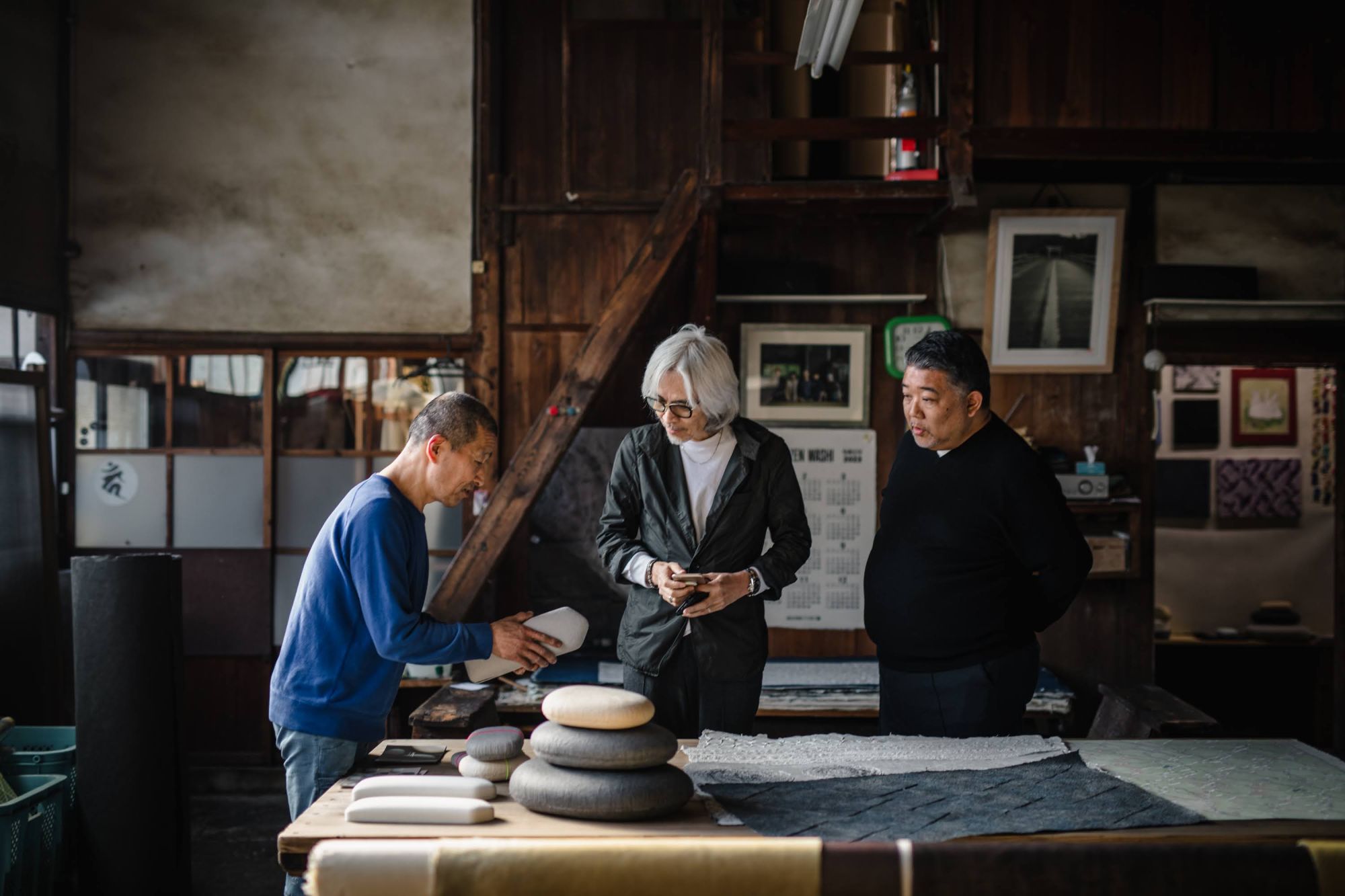 Center:Ryu Kosaka
Center:Ryu Kosaka
The Creative Director of A.N.D., Nomura Kogeisha Corporation.After graduating from Musashino Art University, Department of Architecture, he joined the company. Major works include “Mandarin Oriental, Tokyo” in 2005, “Shin-Marunouchi Building” in 2007, “LA BOUTIQUE de joel Robuchon” in 2009, and “PALACE HOTEL Japanese Cuisine Floor” in 2012.
Right:Makoto Oikawa.
Representative of Bamboo Media, Inc.After working as an editor and editor-in-chief of the commercial space design magazine "Monthly Shoten kenchiku", he founded Bamboo Media in 2010.He is the organizer of “BAMBOO MEDIA,” a web magazine introducing commercial space design in Japan and abroad, and “BAMBOO EXPO,” an exhibition of interior materials.
Prior to BAMBOO EXPO 19, a commercial space exhibition to be held in Tokyo on May 17-18, 2023, the two came to the production area to experience Echizen Washi paper, which has been attracting attention as a construction material in recent years. This is Mr. Oikawa's second visit to the Echizen washi production area. This is the first time for Mr. Kosaka. First, we started our journey at the sacred place of Echizen washi paper to uncover the story of this region.
▲You can also view a digital pamphlet summarizing Mr.Kosaka and Mr.Oikawa's journey.
The Imadate district of Echizen City is still lined with washi paper studios along the river.
Continuing down the charming street, we came to “Okamoto Otaki Shrine”, where the goddess of paper is enshrined.
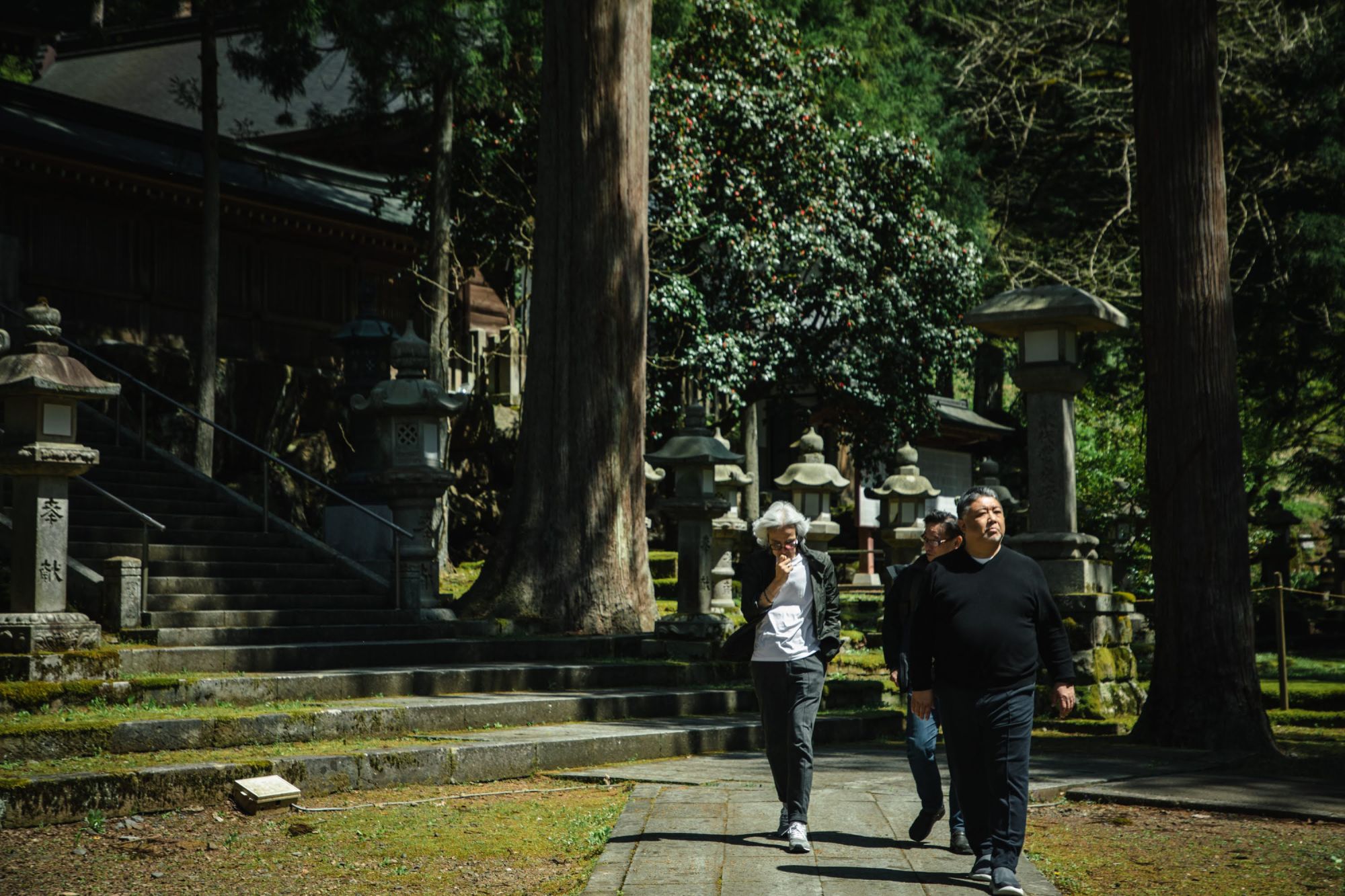 Among Japan's washi-producing regions, Echizen Washi stands out as the finest in terms of quality, variety, and production volume, earning its place among Japan's three great washi papers.
Among Japan's washi-producing regions, Echizen Washi stands out as the finest in terms of quality, variety, and production volume, earning its place among Japan's three great washi papers.
It originated about 1,500 years ago.It is said that a beautiful princess appeared upstream from the river that runs through this area and taught the villagers the technique of papermaking.Since then, this princess has been called “Goddess of paper, Kawakamigozen” and enshrined at Okamoto Shrine.
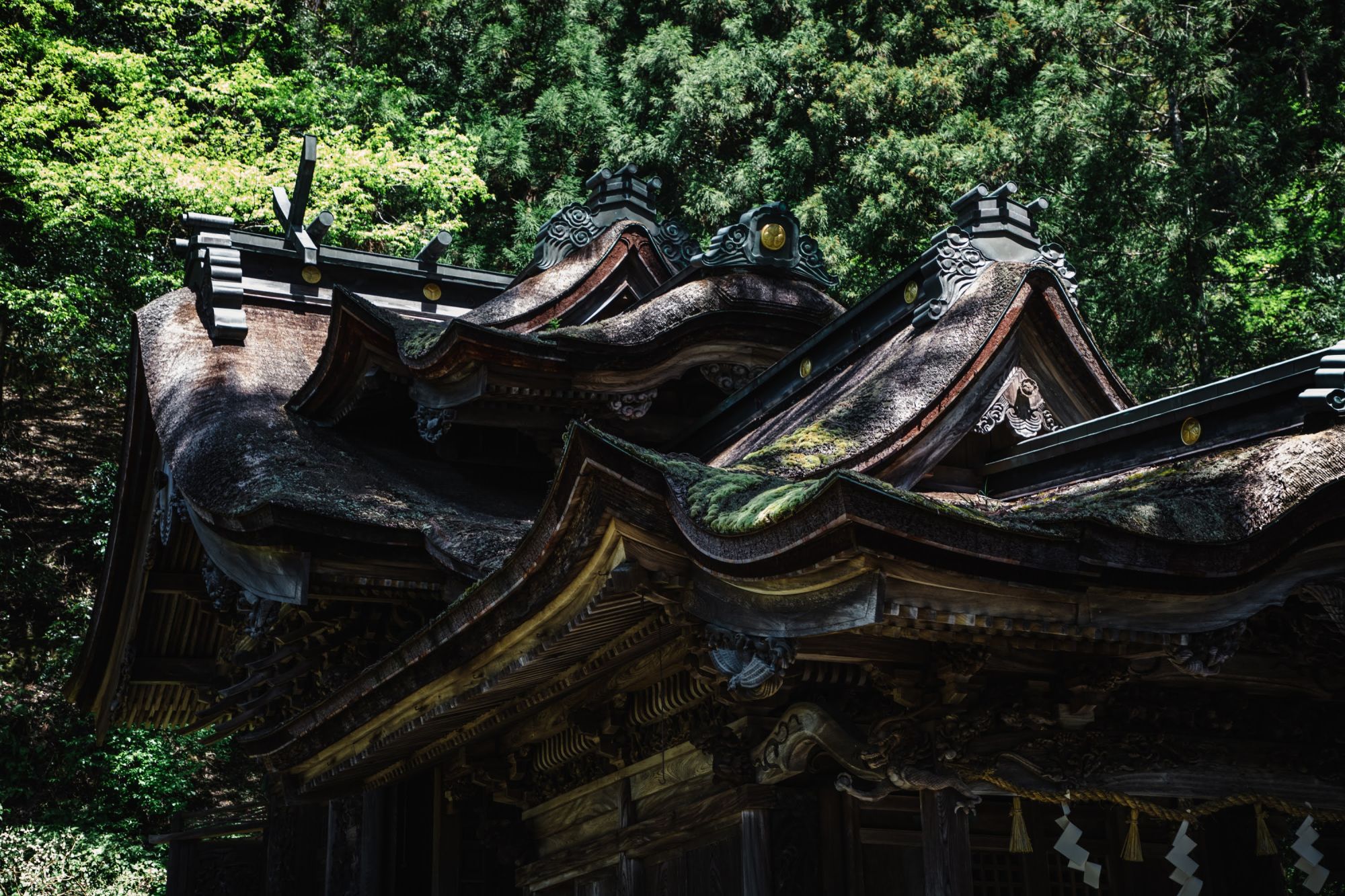 The shrine, rebuilt in the late Edo period, has also attracted attention as the most complex shrine architecture in Japan.Particularly, the hinoki-bark roof features a unique structure with an irimoya style, chidori gable, karahafu gable, and another irimoya with an overlapping karahafu gable—an architectural form rarely seen anywhere else in Japan.
The shrine, rebuilt in the late Edo period, has also attracted attention as the most complex shrine architecture in Japan.Particularly, the hinoki-bark roof features a unique structure with an irimoya style, chidori gable, karahafu gable, and another irimoya with an overlapping karahafu gable—an architectural form rarely seen anywhere else in Japan.
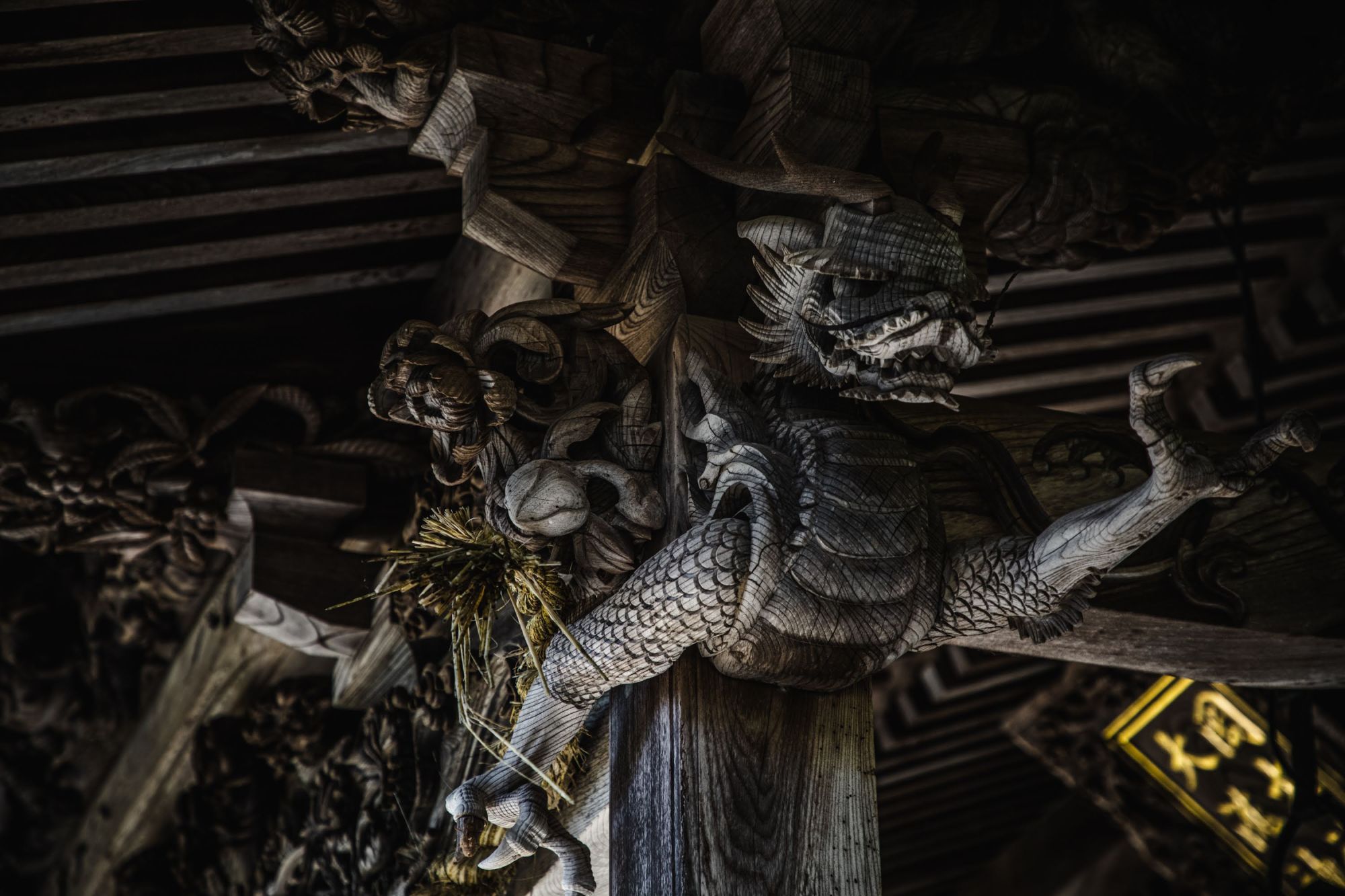 The front of the worship hall is decorated with elaborate lions and dragons, and the sides and back are also decorated with carvings based on Ancient Chinese Myths.
The front of the worship hall is decorated with elaborate lions and dragons, and the sides and back are also decorated with carvings based on Ancient Chinese Myths.
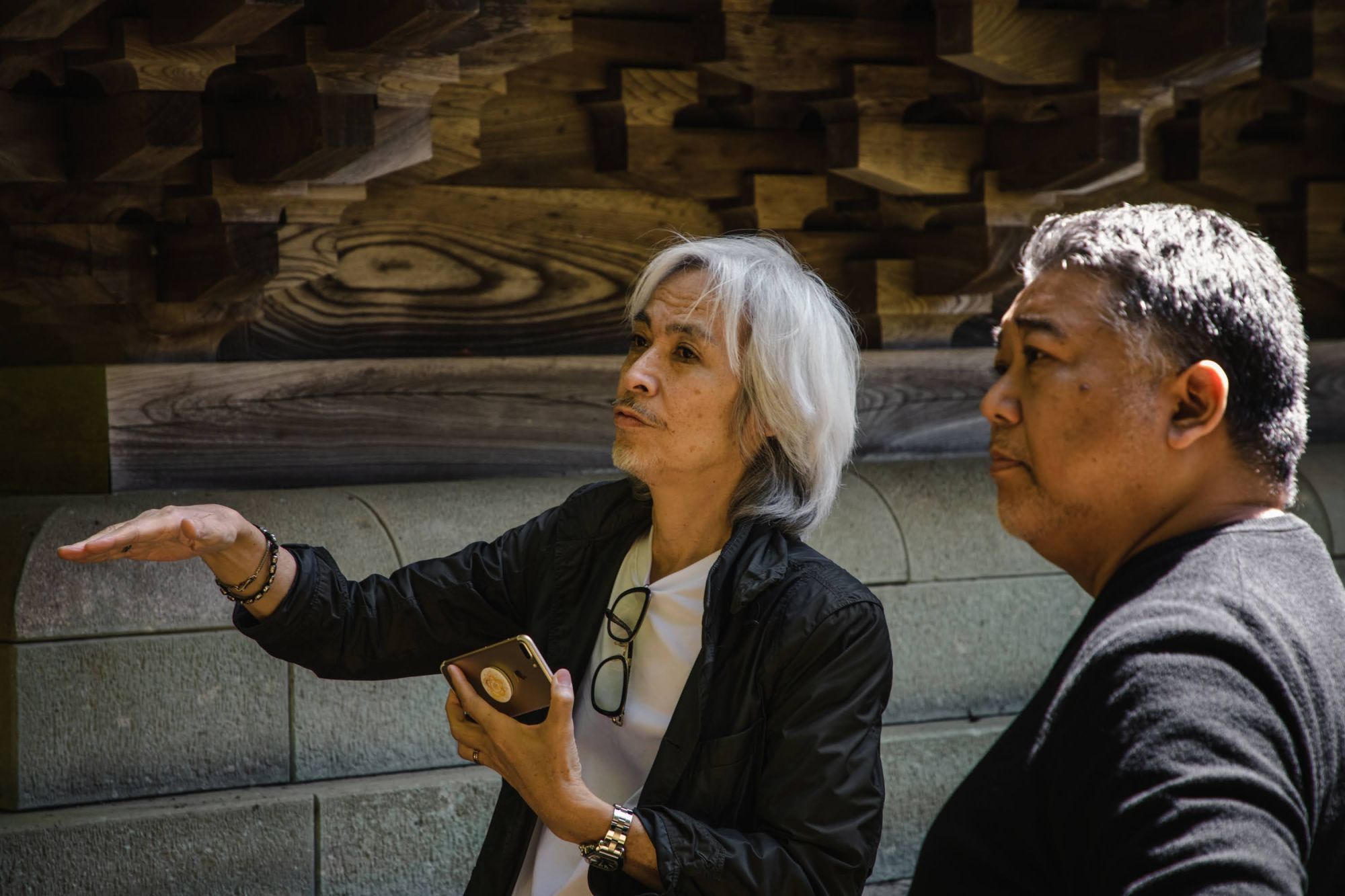
"I think architecture of such beauty and complexity is a manifestation of faith,it makes me feel sacred,” says Mr.Oikawa.
"I like shrines and visit them often, but it is rare to find one with such architectural design and technique throughout.I got good vibes at the beginning of our trip,” said Mr.Kosaka, as he looked around the shrine with great interest.
The next stop was "Udatsu Craft Museum", located in the Echizen Washi Village.The building is a relocated and restored paper-making house from the mid-Edo period, and is the only place in the country where visitors can see the series of processes involved in making washi paper by traditional craftsmen using traditional tools.
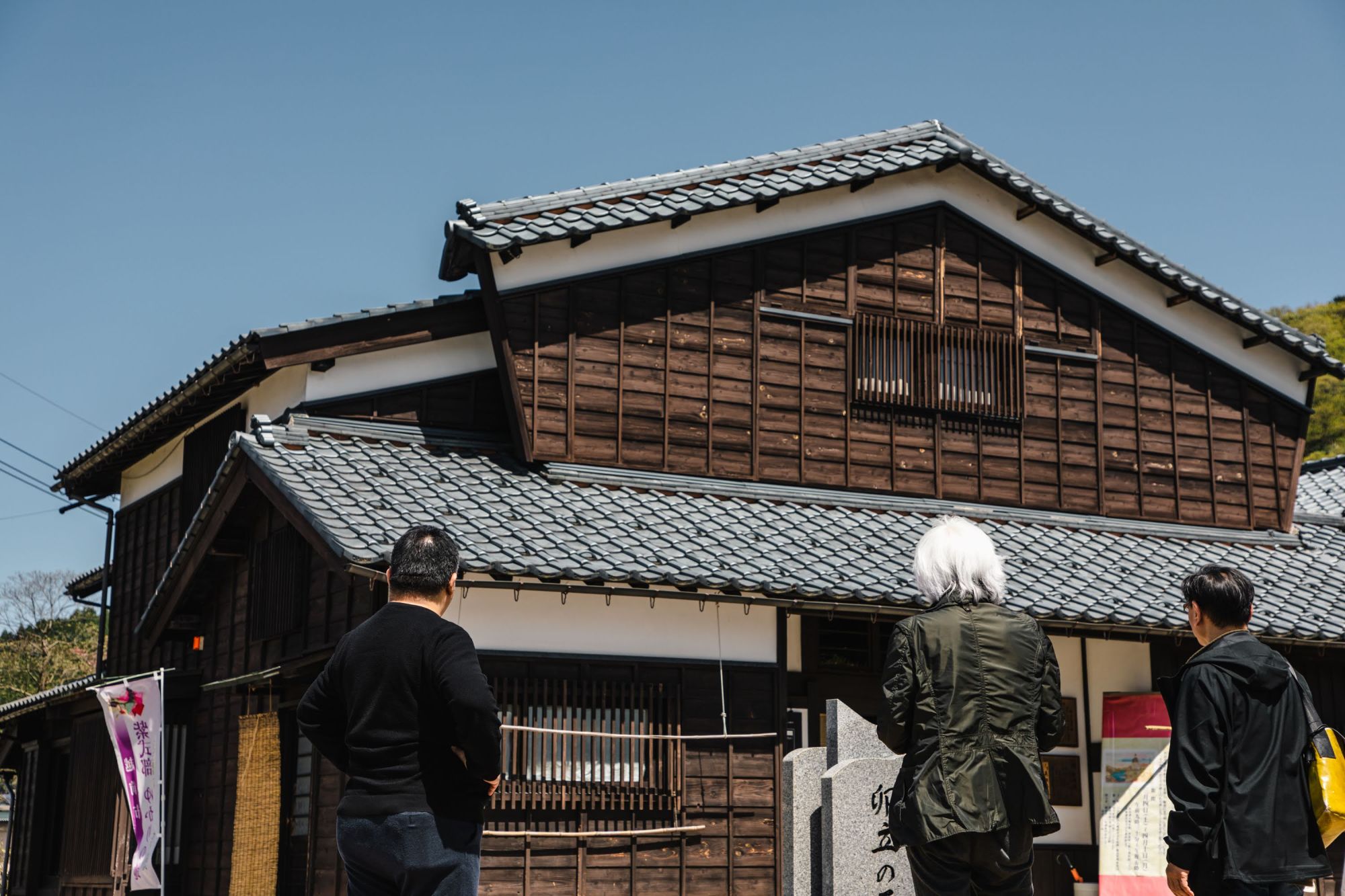 "Udatsu” originally served as firewalls to prevent the spread of fire between neighboring houses, but around the middle of the Edo period, they began to be used for decorative purposes.The “Udatsu” of this building was also built facing the front, a shape commonly seen in private houses in this area.
"Udatsu” originally served as firewalls to prevent the spread of fire between neighboring houses, but around the middle of the Edo period, they began to be used for decorative purposes.The “Udatsu” of this building was also built facing the front, a shape commonly seen in private houses in this area.
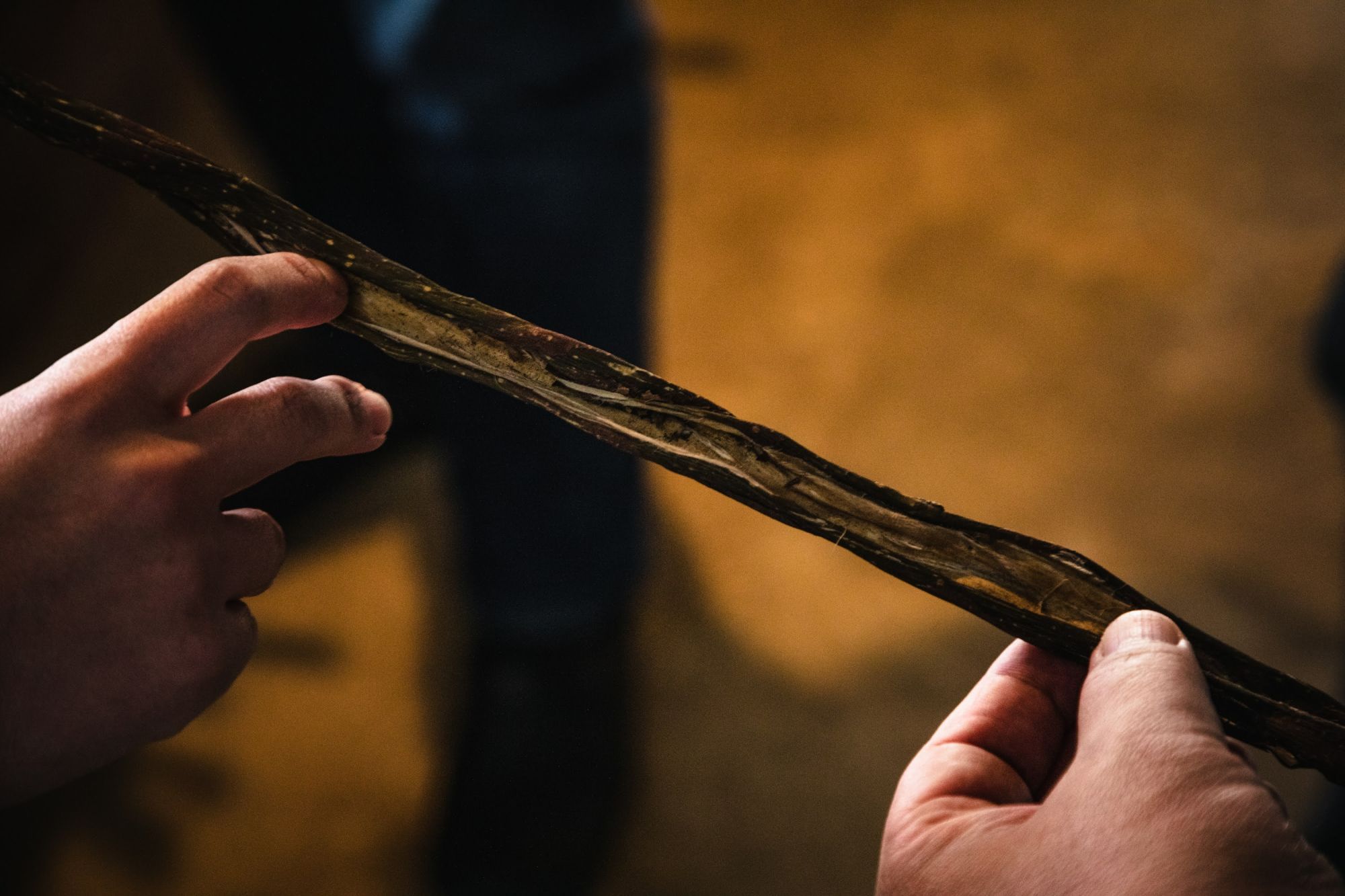 Echizen washi is made from kozo (paper mulberry), mitsumata, and gampi.The bark is boiled to soften it, and the tender white skin under the black outer bark is used as the centerpiece.
Echizen washi is made from kozo (paper mulberry), mitsumata, and gampi.The bark is boiled to soften it, and the tender white skin under the black outer bark is used as the centerpiece.
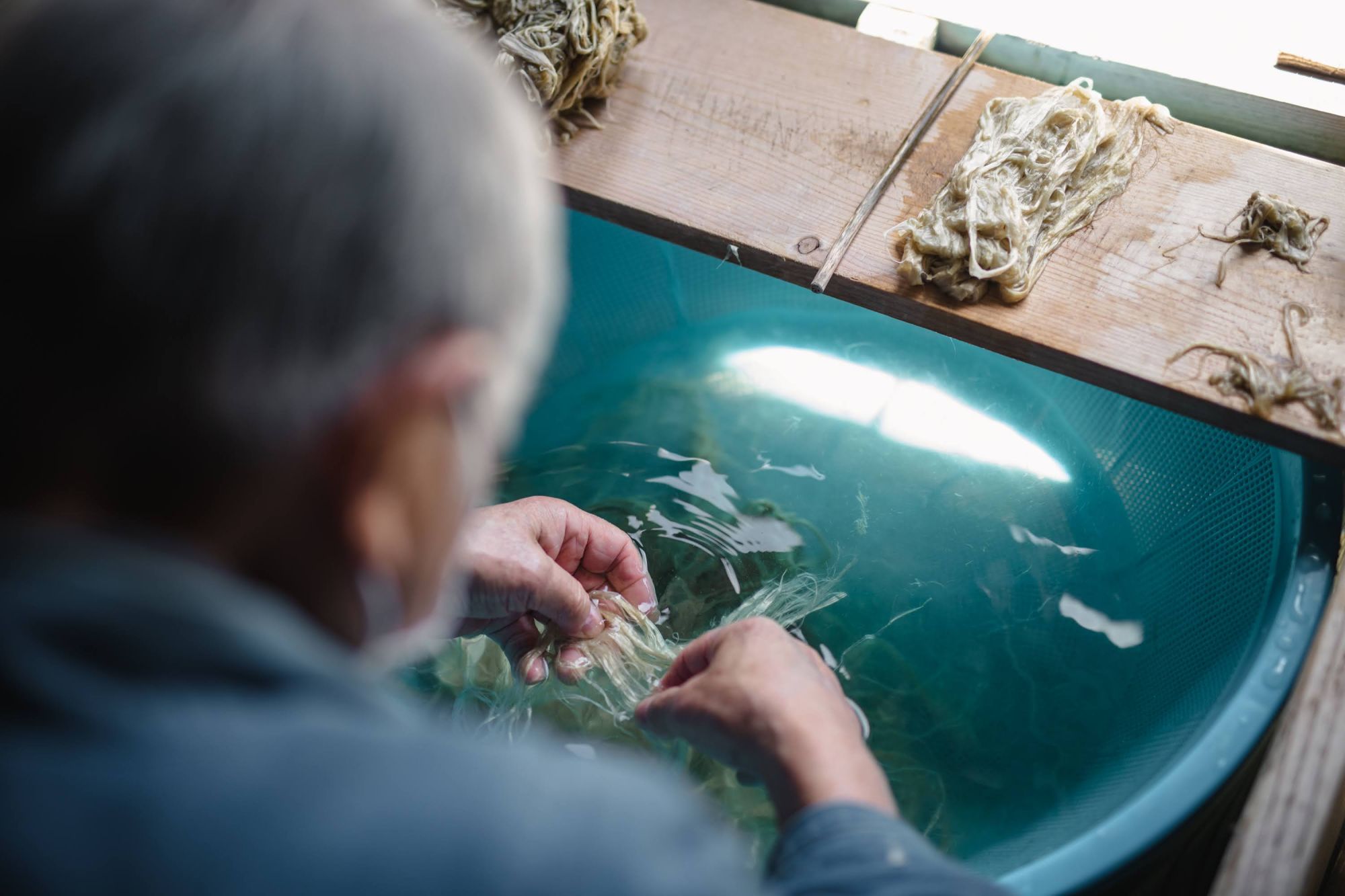 There was also “Chiriyori” work going on in the museum."Chiriyori" is a labor-intensive process of removing impurities such as the black skin and the tough, fibrous parts remaining on the peel.This process is essential for making beautiful washi, and is repeated many times to thoroughly remove dust.
There was also “Chiriyori” work going on in the museum."Chiriyori" is a labor-intensive process of removing impurities such as the black skin and the tough, fibrous parts remaining on the peel.This process is essential for making beautiful washi, and is repeated many times to thoroughly remove dust.
Paper making is usually done in the harsh winter months, and the “chiriyori” process requires hands to be submerged in cold water for hours.It is through such harsh work that the raw materials for washi are produced.
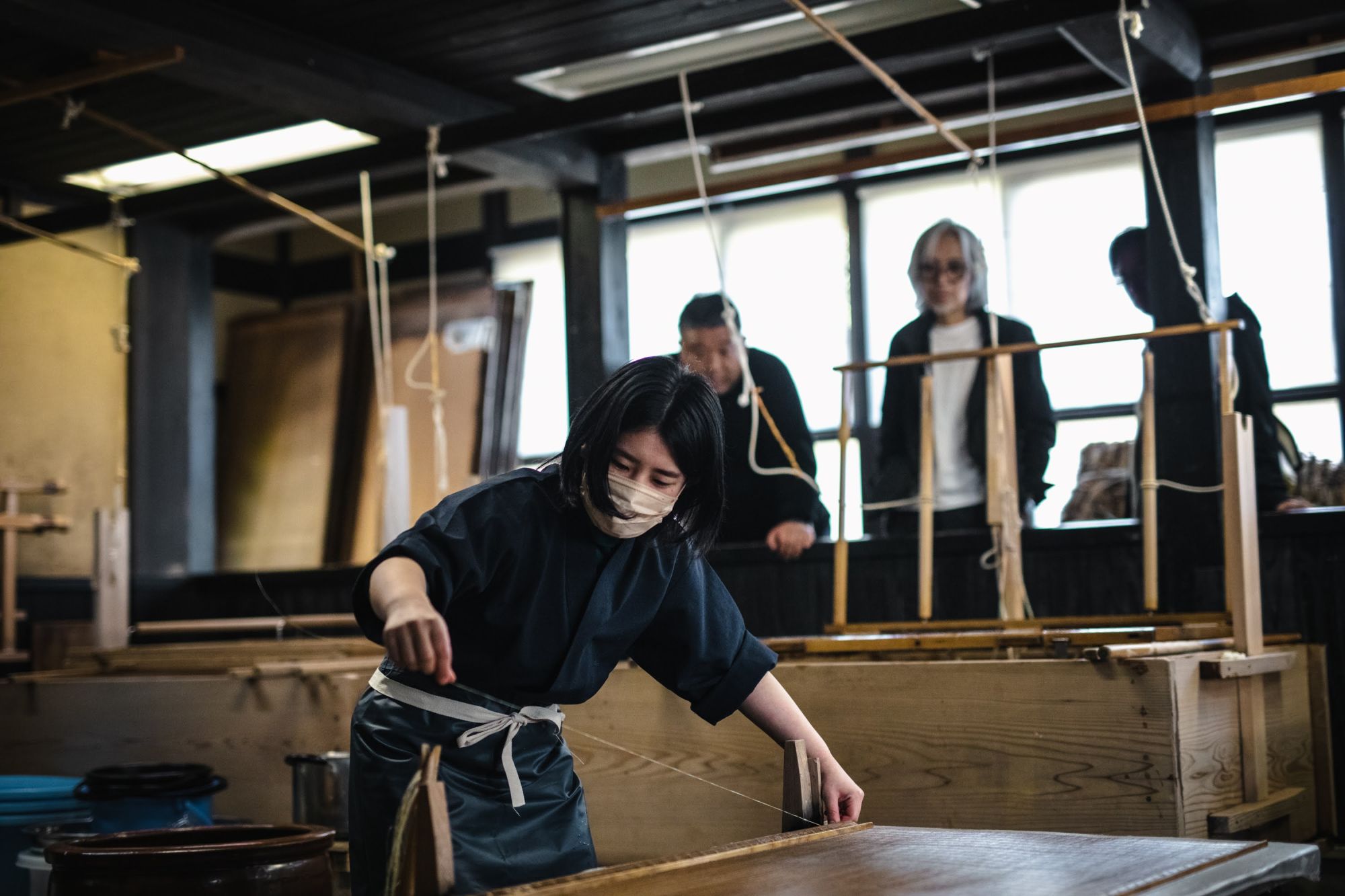 The craftsman who explained the process to us with a friendly smile quickly changed his expression to a crisp one as soon as he started to make the paper.The graceful motion of sheets being formed one after another is so captivating that you can't help but be mesmerized.
The craftsman who explained the process to us with a friendly smile quickly changed his expression to a crisp one as soon as he started to make the paper.The graceful motion of sheets being formed one after another is so captivating that you can't help but be mesmerized.
Witnessing the centuries-old technique of paper-making that has remained unchanged, I once again truly realized how time-consuming and labor-intensive the process is.
After seeing the craftsmanship up close, visit the “The Paper Culture Museum.”Here, visitors can learn about the history of washi and view exhibits of various types of paper made in the region.
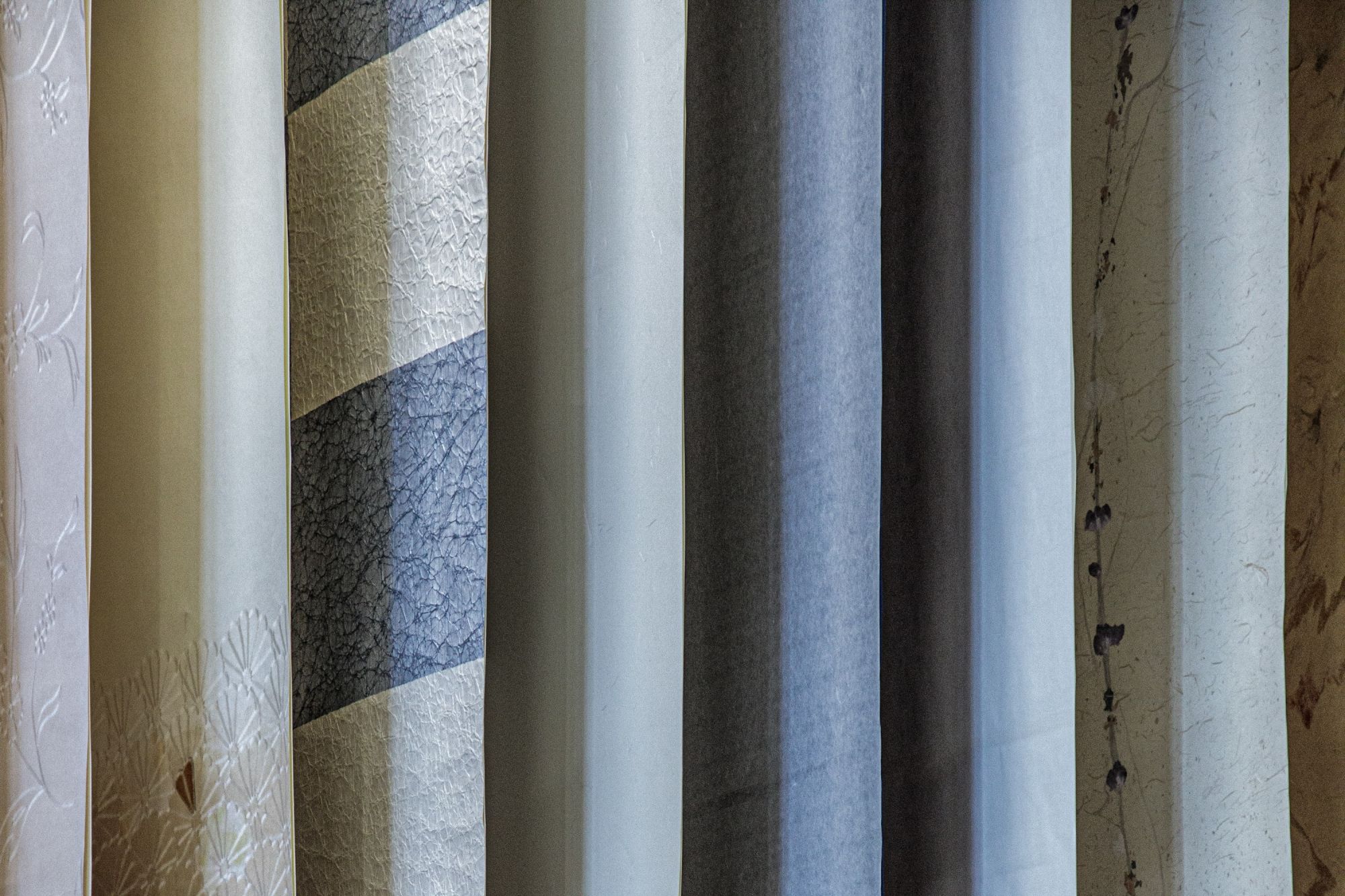 The annex exhibits about 125 pieces of Japanese paper representing the region.Echizen washi, in a nutshell, comes in a variety of forms, from pure white paper to those that are colored or processed in different ways.Some papers are made by living national treasures.
The annex exhibits about 125 pieces of Japanese paper representing the region.Echizen washi, in a nutshell, comes in a variety of forms, from pure white paper to those that are colored or processed in different ways.Some papers are made by living national treasures.
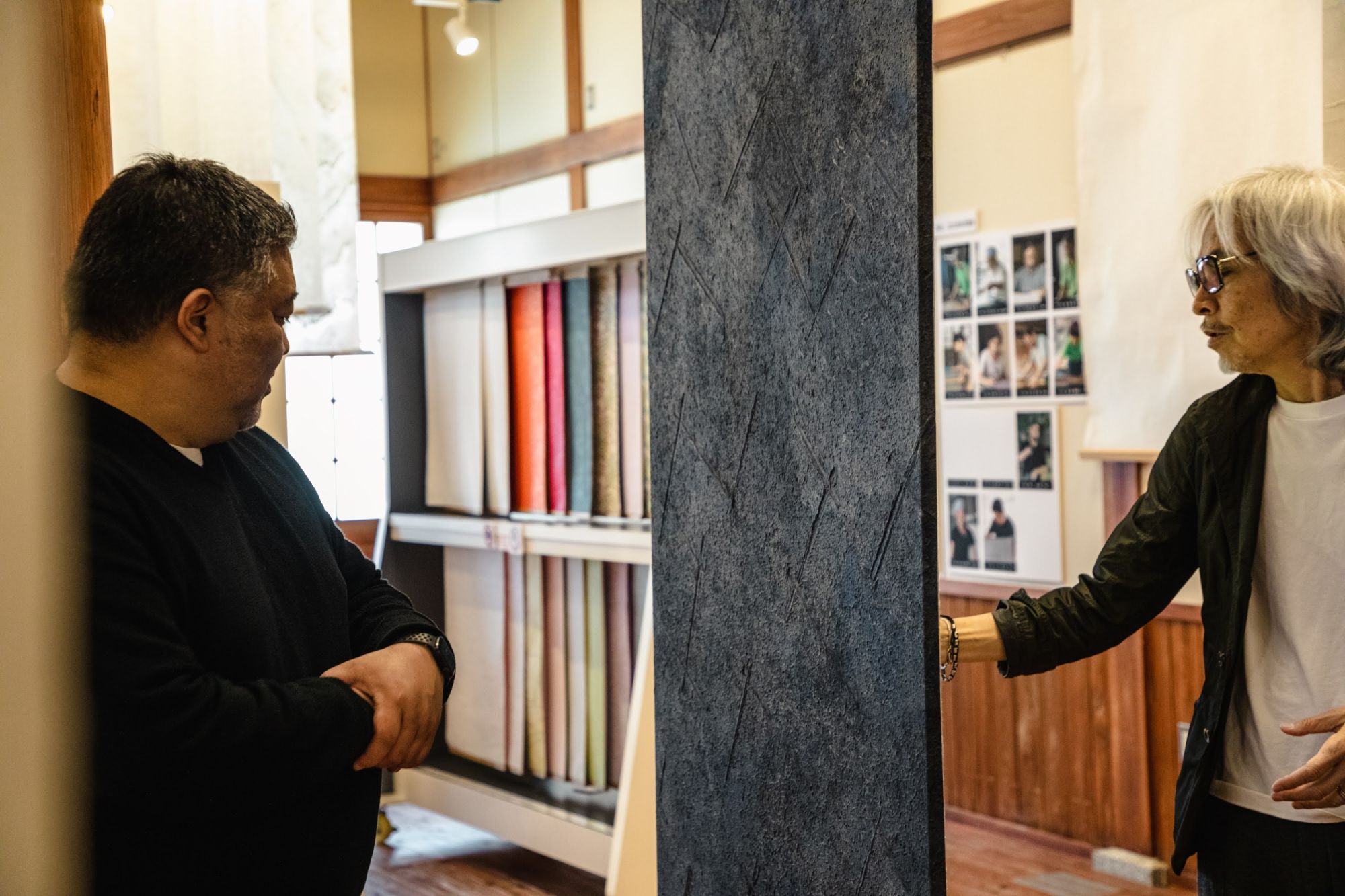 Recently, Echizen washi, which has obtained "fireproof certification," has been increasingly used as building material.
Recently, Echizen washi, which has obtained "fireproof certification," has been increasingly used as building material.
As soon as he heard this, Mr. Kosaka began to hold up some kind of cell phone light to the Japanese paper.He is checking the appearance when the lighting is applied.Indeed, when he shines light on the washi, it takes on a different look.
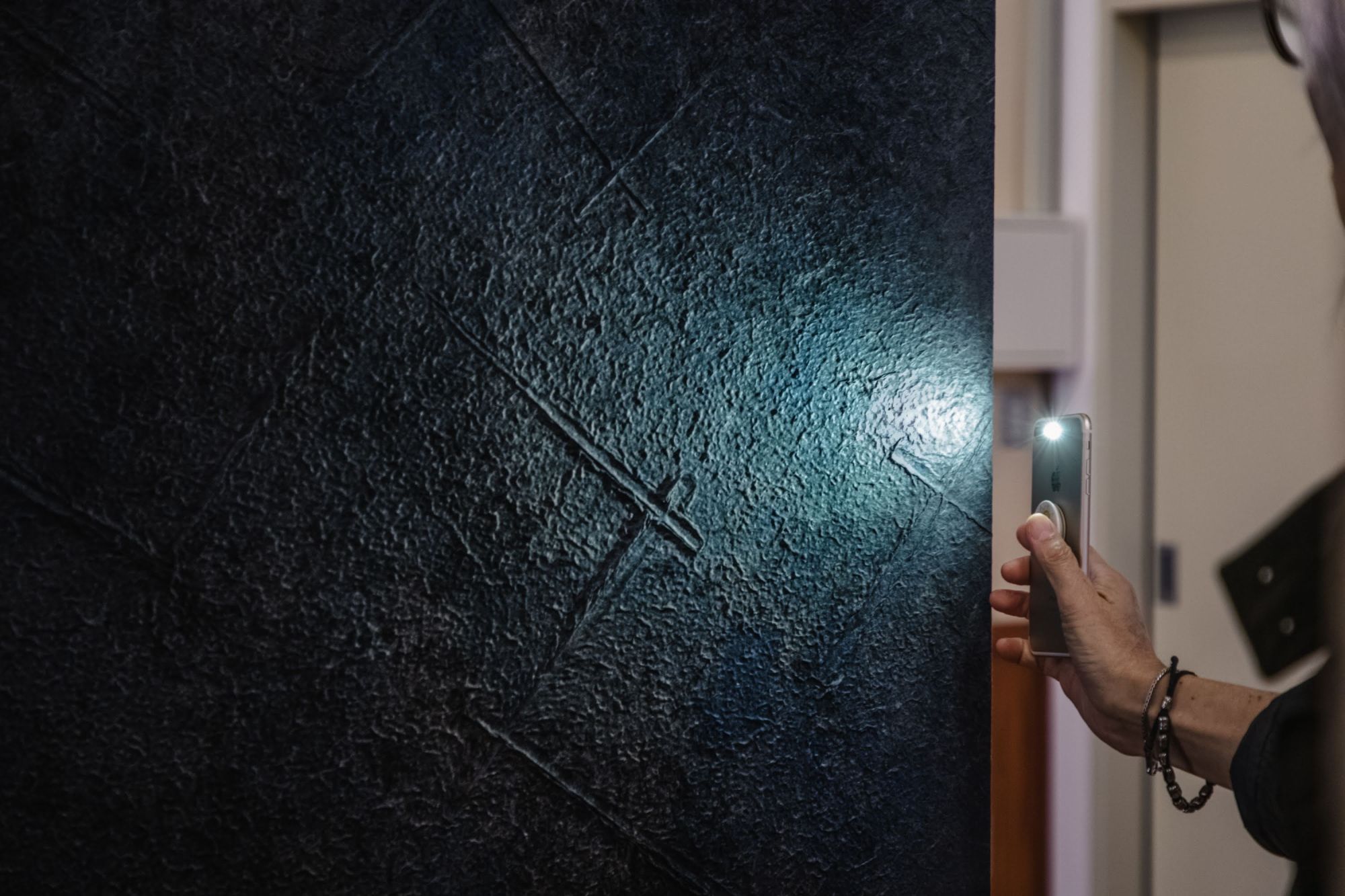 After experiencing the diversity of Echizen washi at the museum, visitors will head to a papermaking workshop where craftsmen actually do the work.What possibilities do Kosaka and Oikawa see in Echizen Washi?
After experiencing the diversity of Echizen washi at the museum, visitors will head to a papermaking workshop where craftsmen actually do the work.What possibilities do Kosaka and Oikawa see in Echizen Washi?
Leaving the museum and walking along the approach to Okamoto Shrine and Otaki Shrine once again, we came across “Yanase Ryozo Paper Mill”.Yanase Ryozo Paper Mills mainly produces “Usukami Kozo-shi,” which is so thin and soft to the touch that light can penetrate through it, as well as a variety of other paper types to meet different needs.
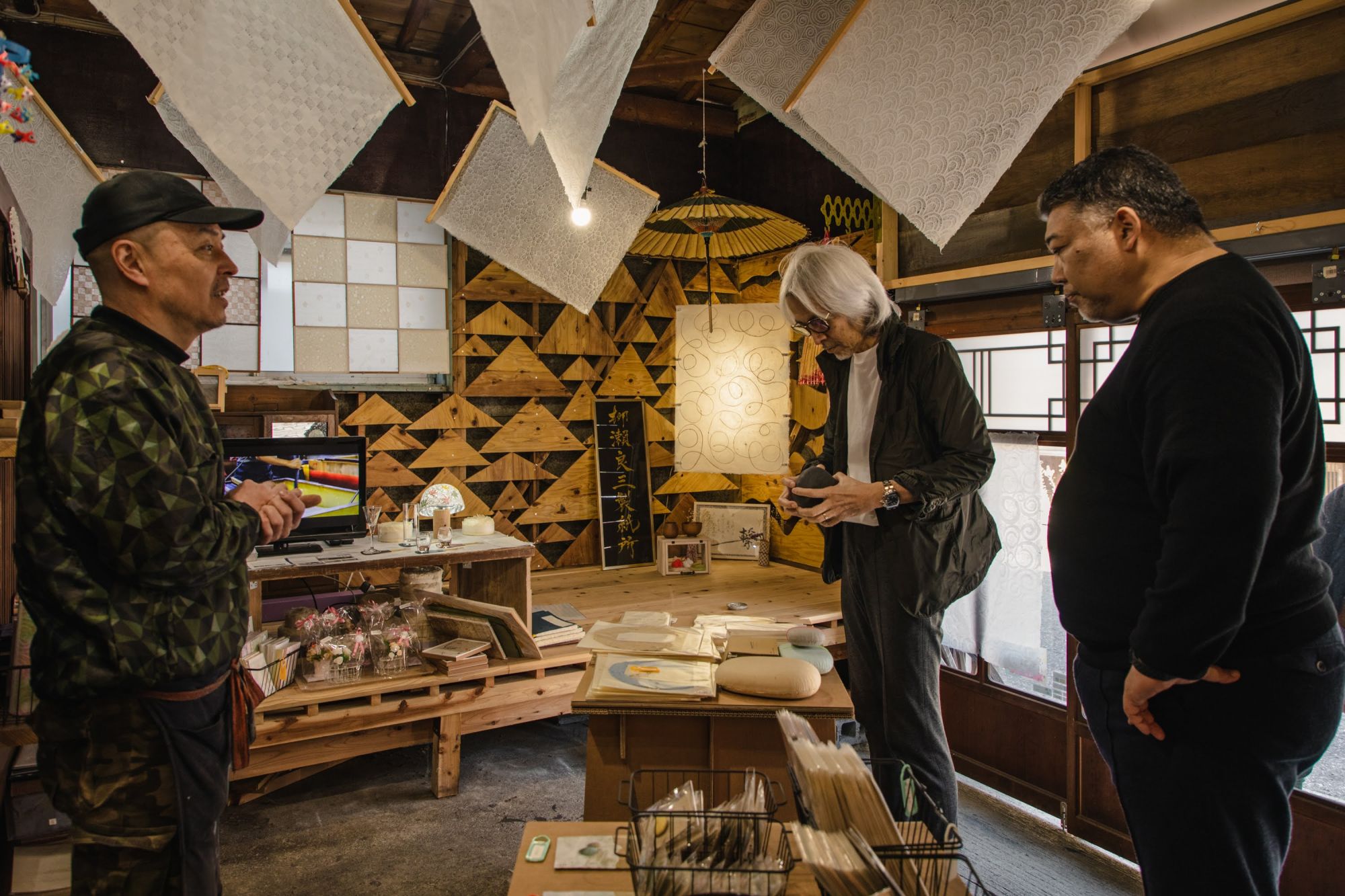 The paper mill also features RYOZO, a directly operated shop converted from a garage, offering a variety of washi items.
The paper mill also features RYOZO, a directly operated shop converted from a garage, offering a variety of washi items.
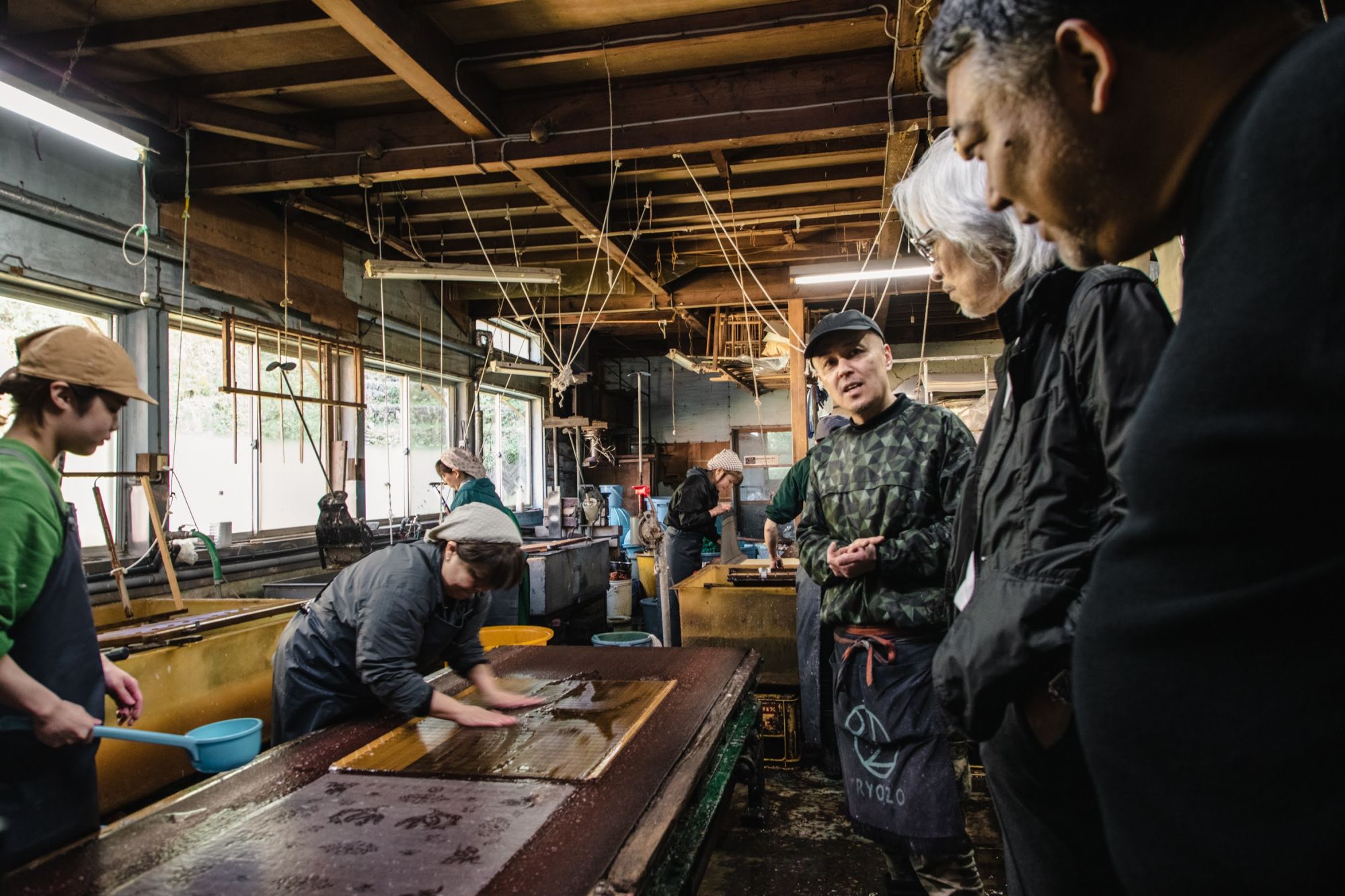 We were allowed to enter the workshop under the guidance of Mr. Yasuhiro Yanagisse.Women craftsmen continue to make washi in the workshop.The average age is 29 years old.
We were allowed to enter the workshop under the guidance of Mr. Yasuhiro Yanagisse.Women craftsmen continue to make washi in the workshop.The average age is 29 years old.
“The god of Echizen washi is a woman.Paper making has traditionally been considered a woman's job, and following that custom, there are still many female artisans today," said Yasuhiro.
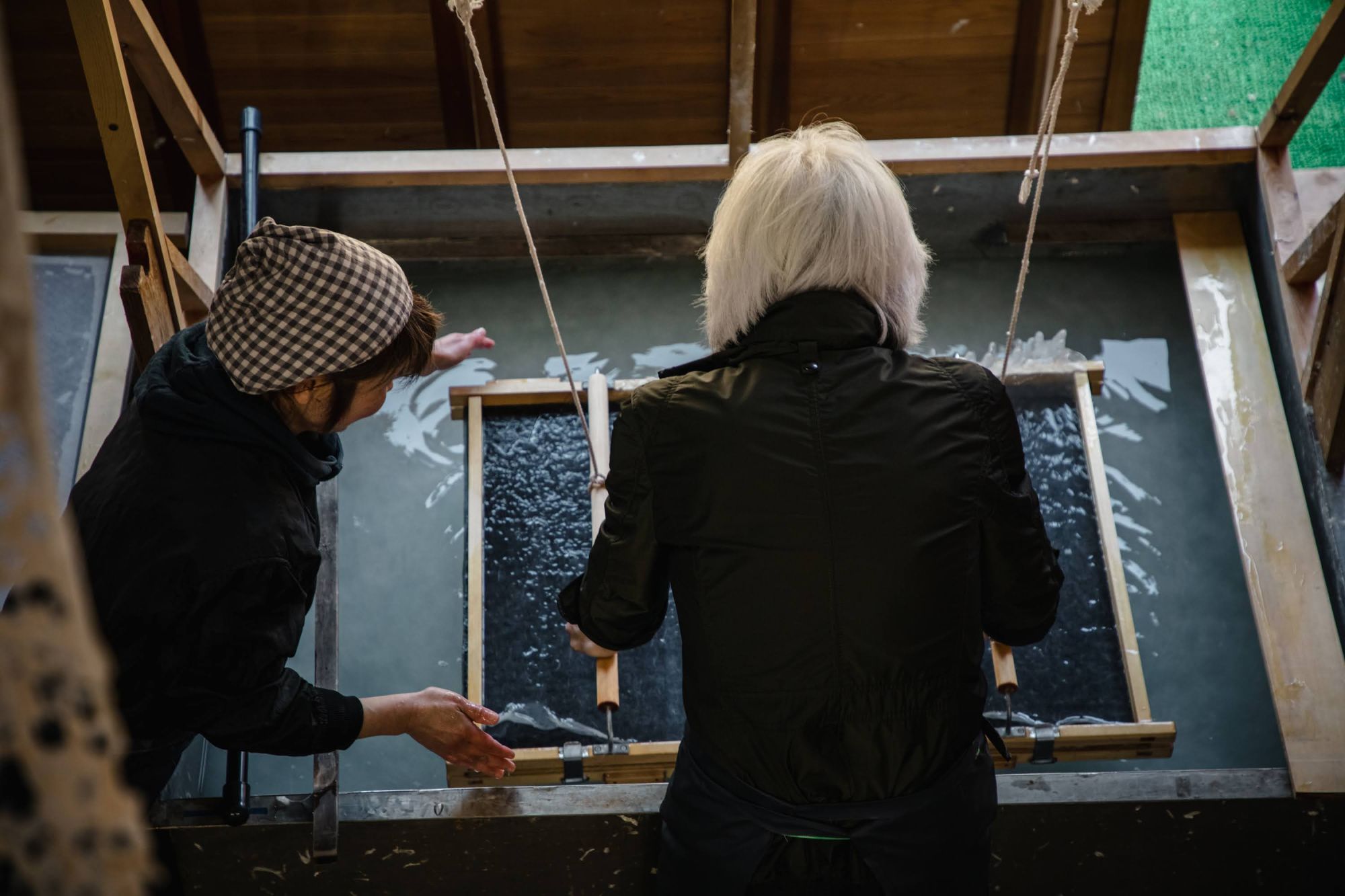 Next to the workshop, there is a space where visitors can try their hand at paper-making, which Kosaka and Oikawa also will try.
Next to the workshop, there is a space where visitors can try their hand at paper-making, which Kosaka and Oikawa also will try.
A tool called a “Keta” is placed in a vat containing raw materials for making washi, and the paper is made by slowly shaking the keta.
"Echizen washi is made by shaking the girders vertically.The craftsmen make light work of it, but many first-timers end up with sore muscles because they have to work so hard,” said Kyoko Yanase, the third generation inheritor of the Yanase Ryozo Paper Mill's techniques.
Kyoko, who is also a traditional craftsman, entered the world of papermaking at the age of 18 and has been dedicated to this profession ever since.“The Kanagata Rakusui-shi,” created using a metal mold technique, is said to be something only Kyoko can produce.
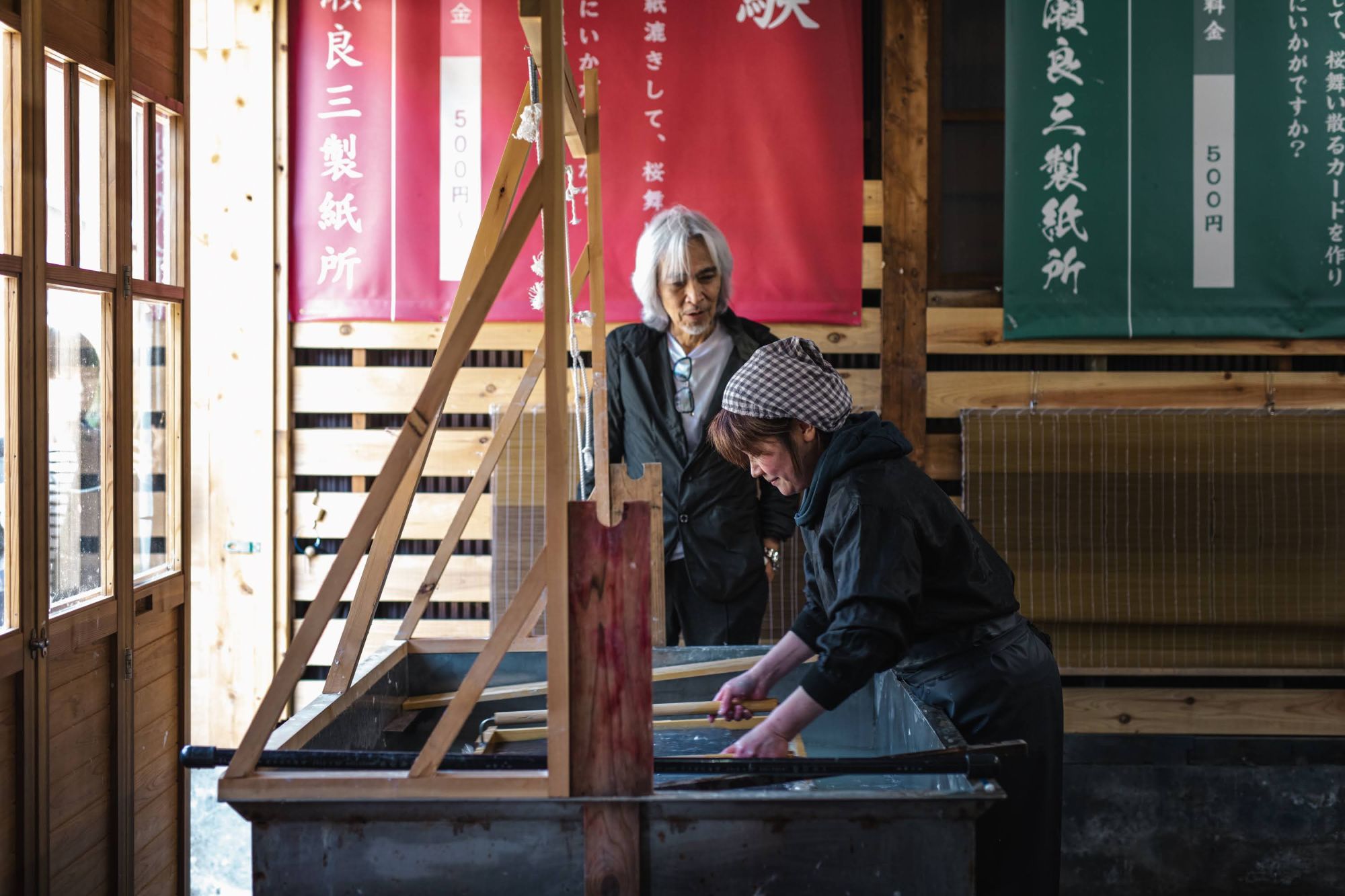 Finally, we were shown Kyoko's paper-making process.
Finally, we were shown Kyoko's paper-making process.
The rhythmic movement of the girders is dynamic.In the quiet space, the only sound that echoes is the gentle tapun, tapun of the slightly viscous water.
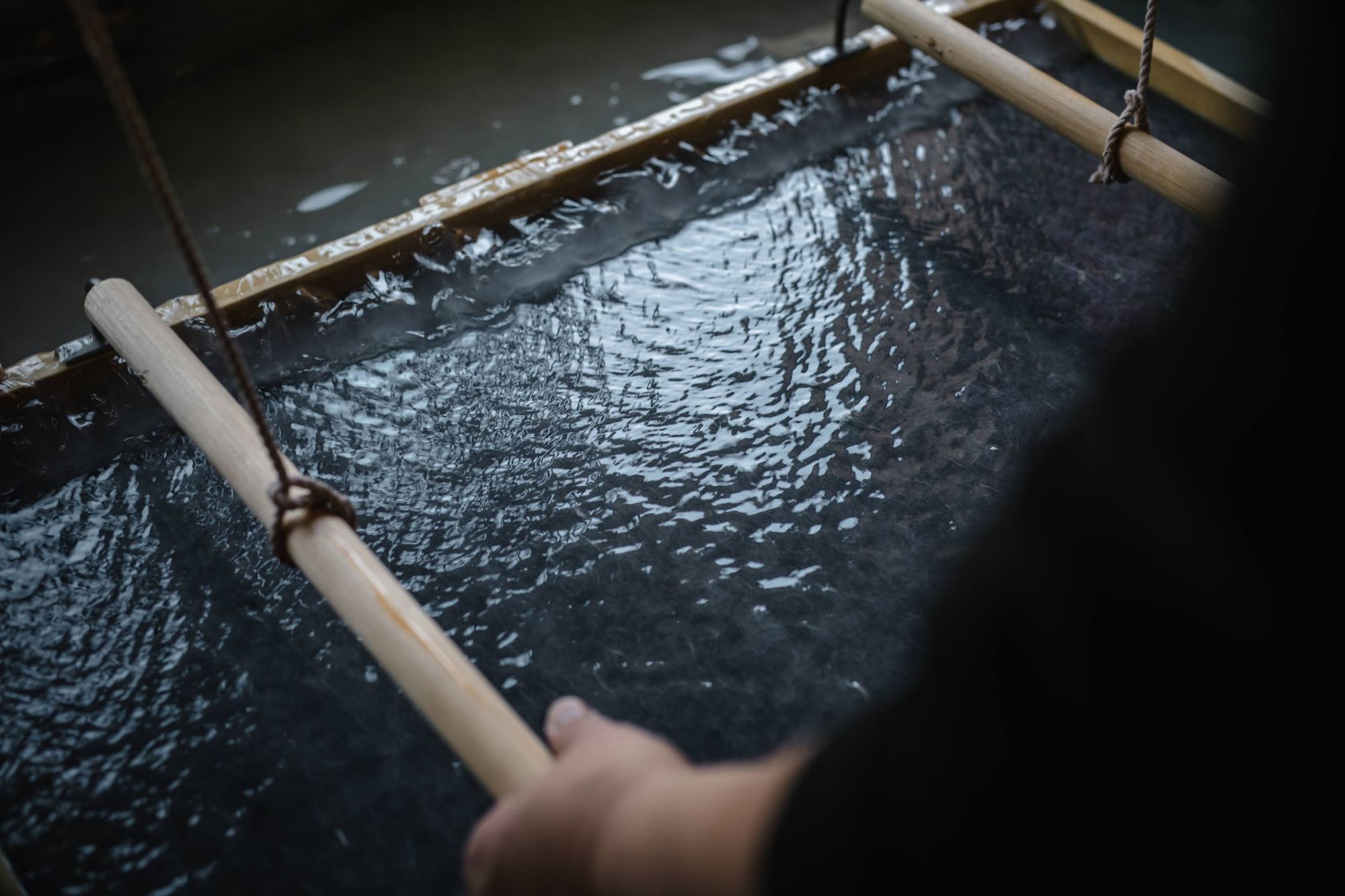 By carefully repeating the papermaking motions, the drifting fibers in the water gradually layer upon each other, forming a single sheet of paper.They were fascinated by such craftsmanship.
By carefully repeating the papermaking motions, the drifting fibers in the water gradually layer upon each other, forming a single sheet of paper.They were fascinated by such craftsmanship.
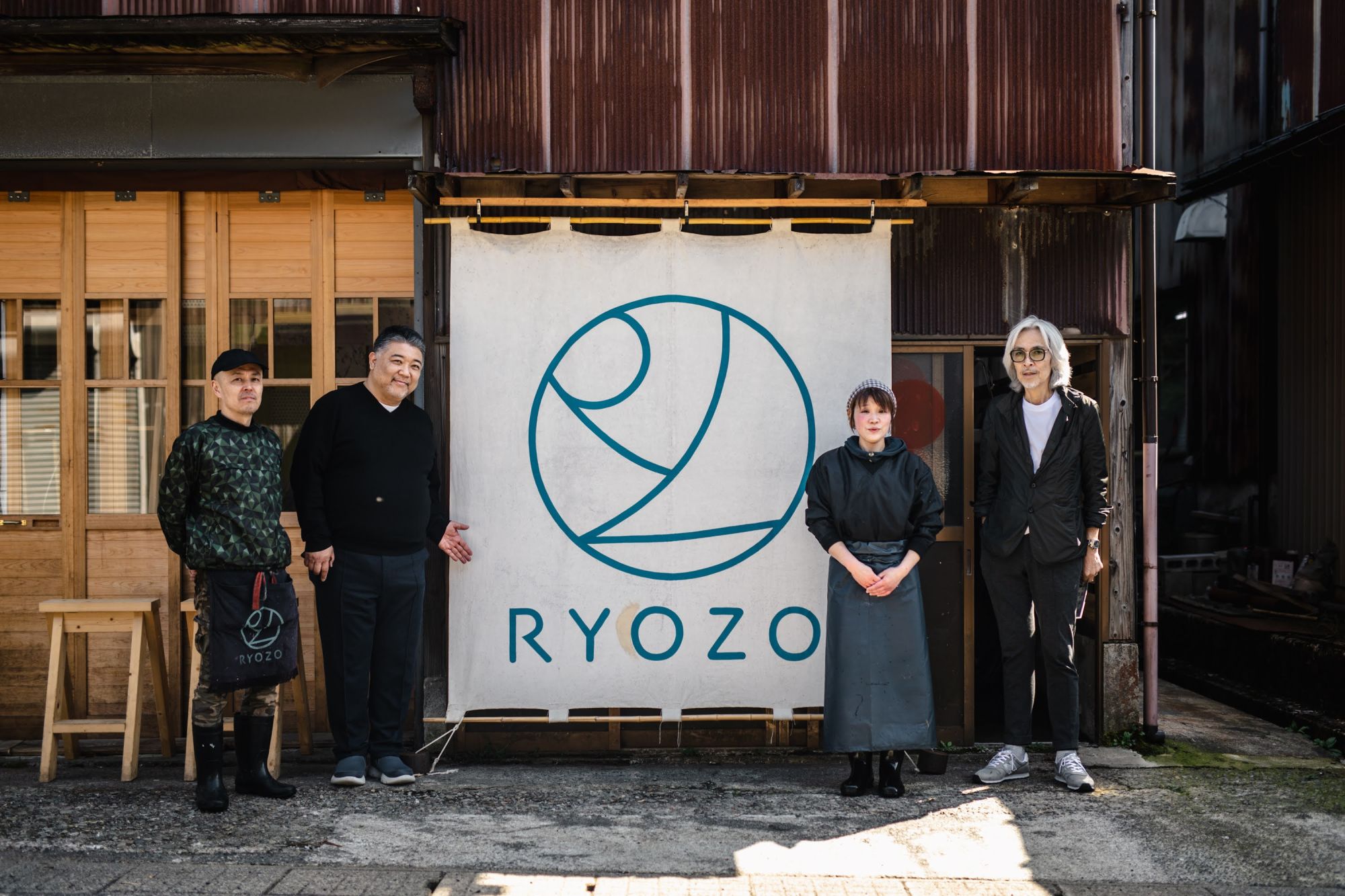
The next stop was “Yamada Keitei Co.,Ltd.”.
In 1882, Kyubei Yamada sixth founded the paper manufacturing business from sericulture, and since then the name “Kyubei” has been passed down from generation to generation.
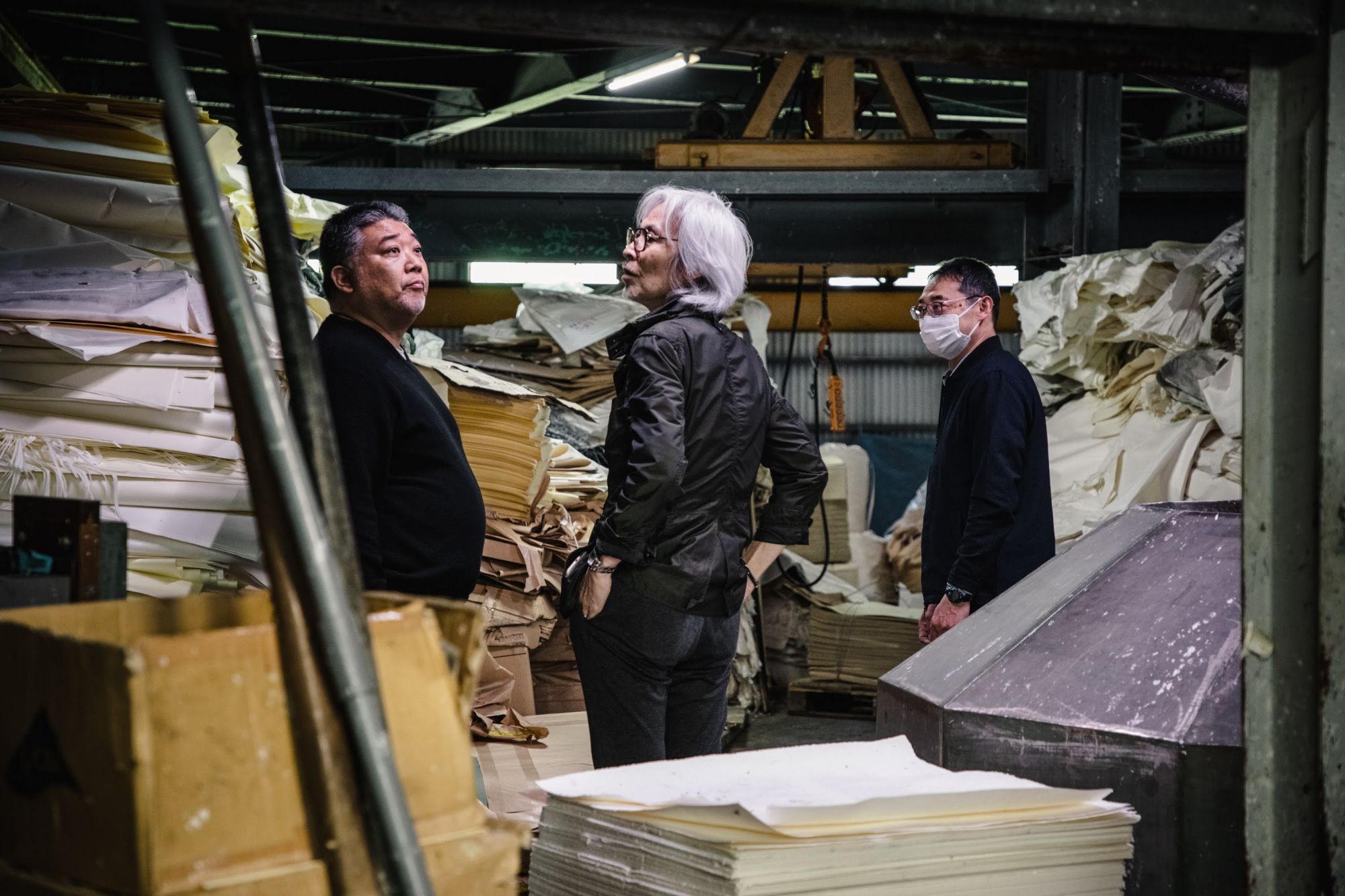 During the seventh generation, the company was involved in making high-quality paper called “bureau paper,” which was used for stock certificates, bonds, and securities.Bureau paper was made in the early Meiji period (1868-1912) as a paper for money, when craftsmen from Echizen, Fukui Prefecture, were invited by the Paper Division of the Printing Bureau of the Ministry of Finance.The paper is known for its dense, glossy quality and durability.
During the seventh generation, the company was involved in making high-quality paper called “bureau paper,” which was used for stock certificates, bonds, and securities.Bureau paper was made in the early Meiji period (1868-1912) as a paper for money, when craftsmen from Echizen, Fukui Prefecture, were invited by the Paper Division of the Printing Bureau of the Ministry of Finance.The paper is known for its dense, glossy quality and durability.
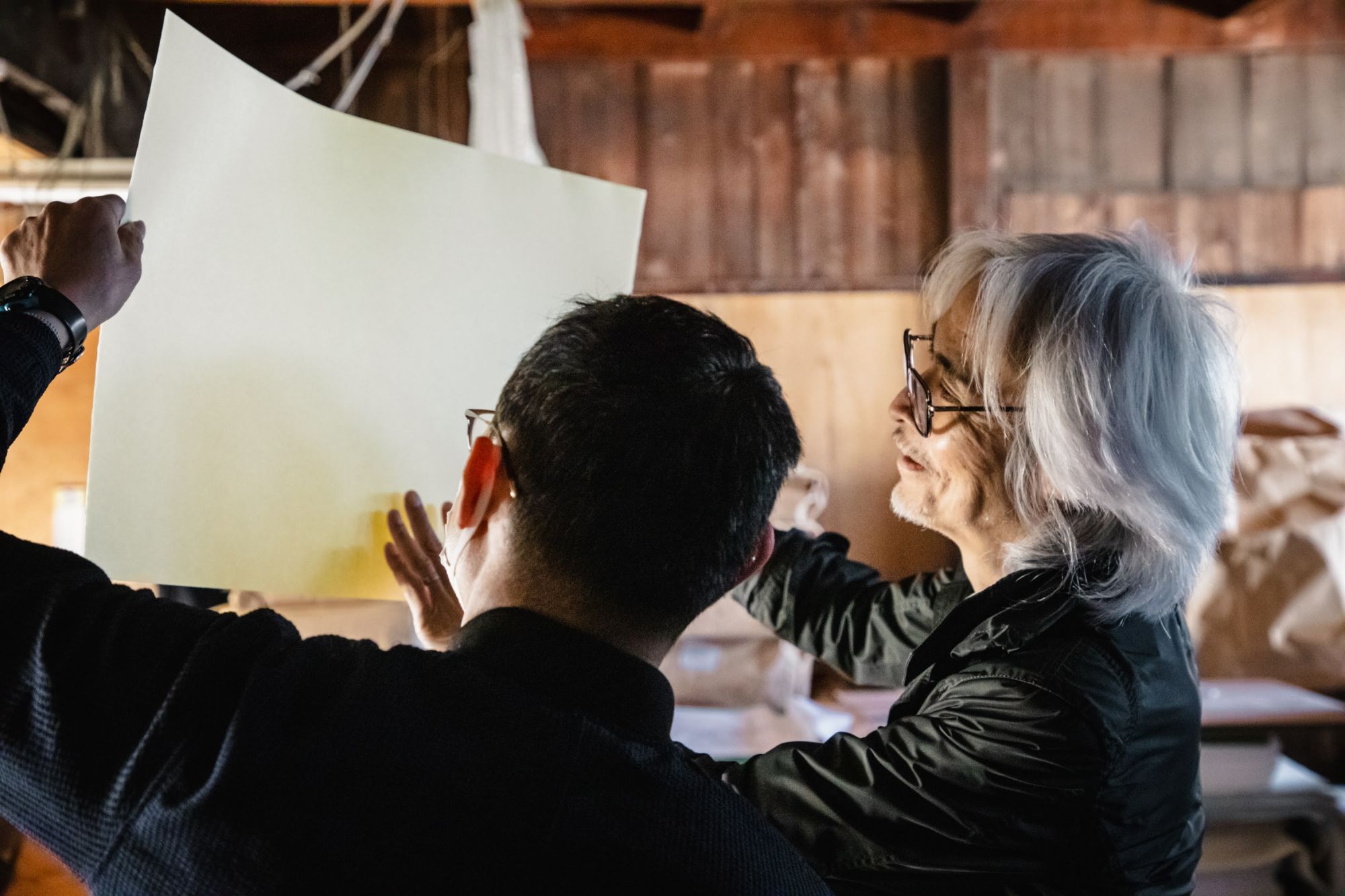
 Because they are used for stock certificates and securities, the quality standards are very strict, and even a single speck of dust can render them unusable.In a corner in the workshop, female craftsmen carefully inspect each piece.
Because they are used for stock certificates and securities, the quality standards are very strict, and even a single speck of dust can render them unusable.In a corner in the workshop, female craftsmen carefully inspect each piece.
Today, the ninth-generation head serves as chairman, while the tenth-generation head is president. Building on techniques refined through securities paper production, they create a variety of washi, including traditional sukashi-gami (watermarked washi) and vibrant sukiawase-gami (layered washi).
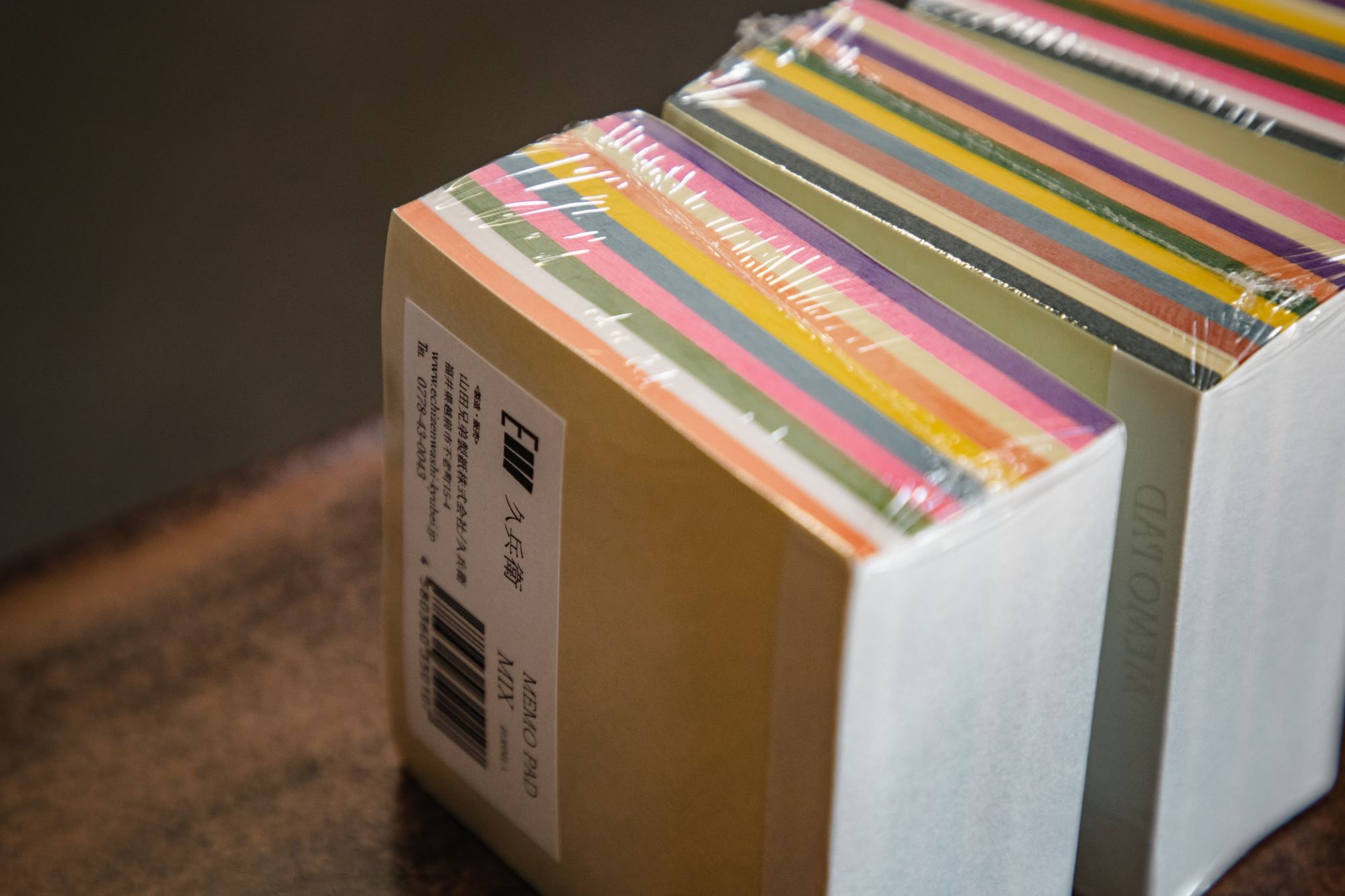 Since 2001, the company has also been focusing on the production of environmentally friendly washi paper, such as “reed paper” made from reeds and “unka-gami” made from 98% recycled paper such as old newspapers and used half-sheets.
Since 2001, the company has also been focusing on the production of environmentally friendly washi paper, such as “reed paper” made from reeds and “unka-gami” made from 98% recycled paper such as old newspapers and used half-sheets.
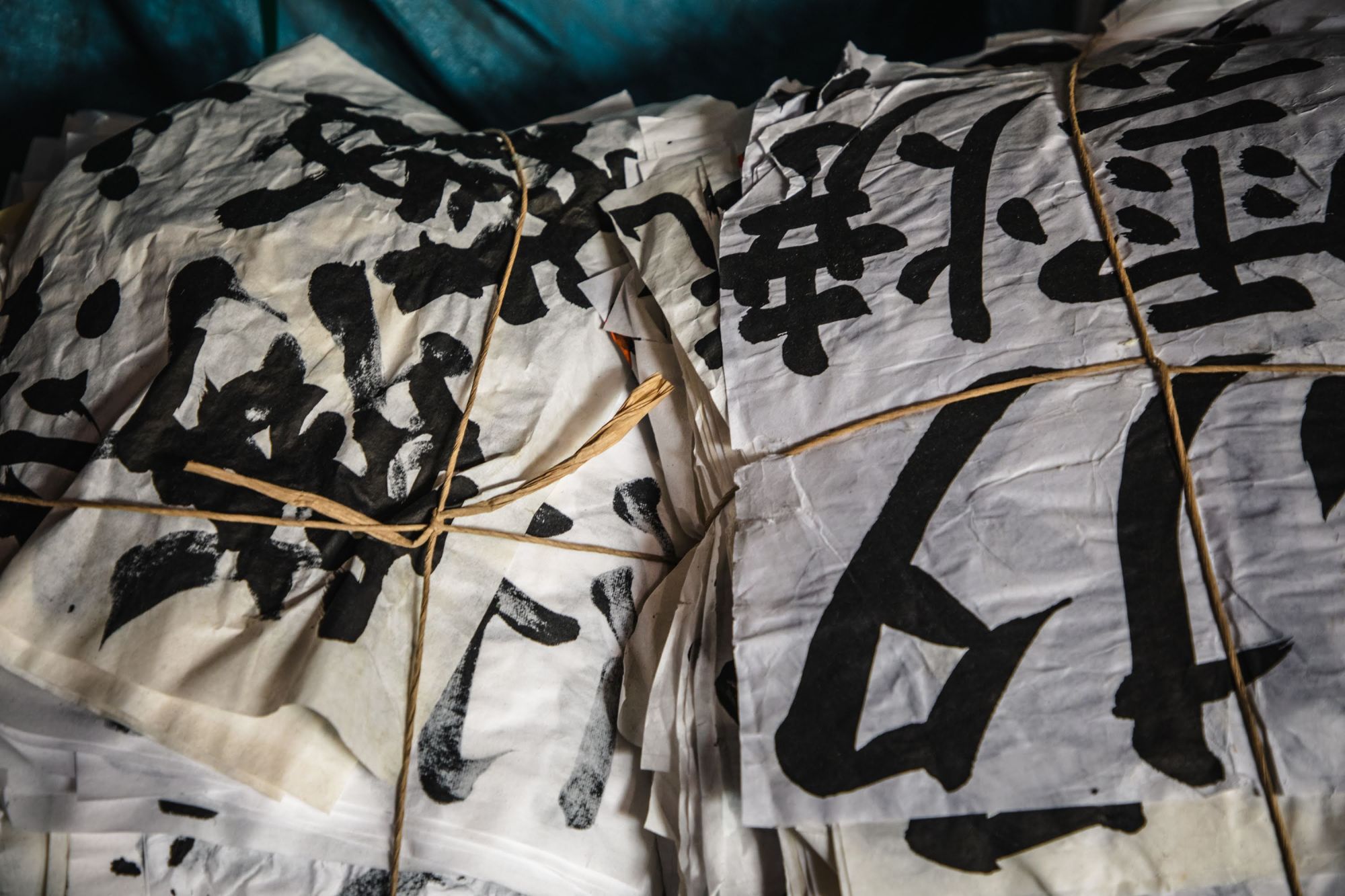 Mr.Oikawa was interested to learn that the same washi paper have many different stories depending on the material used.The new keyword “Echizen Washi paper x environment” may also be a hint for the future.
Mr.Oikawa was interested to learn that the same washi paper have many different stories depending on the material used.The new keyword “Echizen Washi paper x environment” may also be a hint for the future.
A few minutes' walk from Yamada Keitei Co.,Ltd. brought us to our next destination, "the Osada Paper Mills".Osada Paper Mills, founded in 1909, specializes in the production of handmade fusuma paper (sliding door paper), which is rare in Japan.They also produce “rubbing paper,” which is thick sliding door paper that has been hand rubbed to give it a deep wrinkle finish, and washi made from only natural raw materials without the use of chemicals.
 " The first generation made plain sliding door paper, but as time went by, they decided to do something a little more elaborate by hand, so our grandmother designed the mountains and clouds while making the paper by hand.Although it is a traditional pattern, it became a mainstream product in our company,” the head of the company, Kazuya Osada, told us.
" The first generation made plain sliding door paper, but as time went by, they decided to do something a little more elaborate by hand, so our grandmother designed the mountains and clouds while making the paper by hand.Although it is a traditional pattern, it became a mainstream product in our company,” the head of the company, Kazuya Osada, told us.
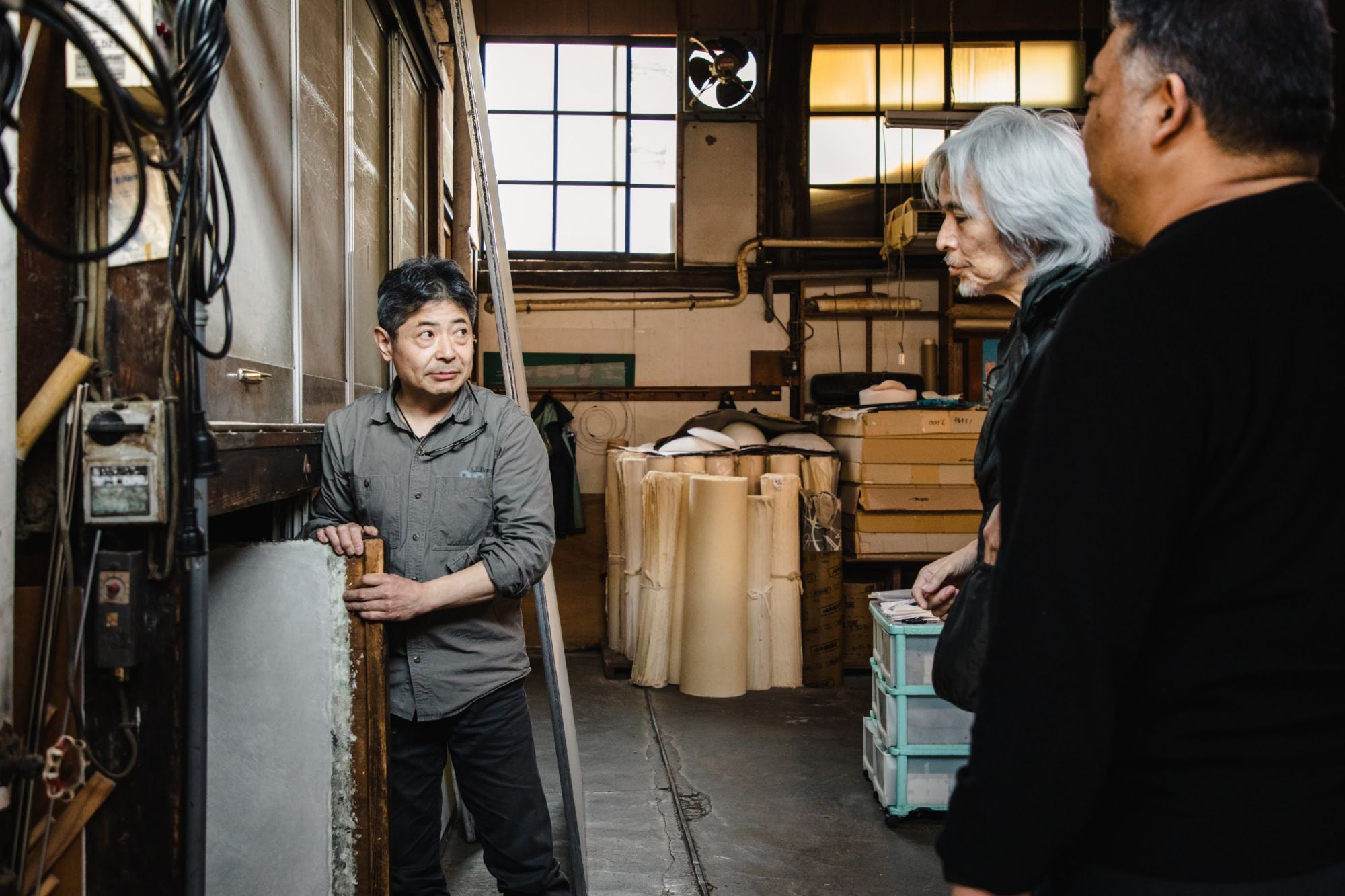 In addition, Mr. Osada has developed a technique called “Hiryu,” in which sticky raw materials are flown into the air to create a pattern on the washi, resulting in complex patterns and a unique texture that cannot be achieved with machine-made washi.
In addition, Mr. Osada has developed a technique called “Hiryu,” in which sticky raw materials are flown into the air to create a pattern on the washi, resulting in complex patterns and a unique texture that cannot be achieved with machine-made washi.
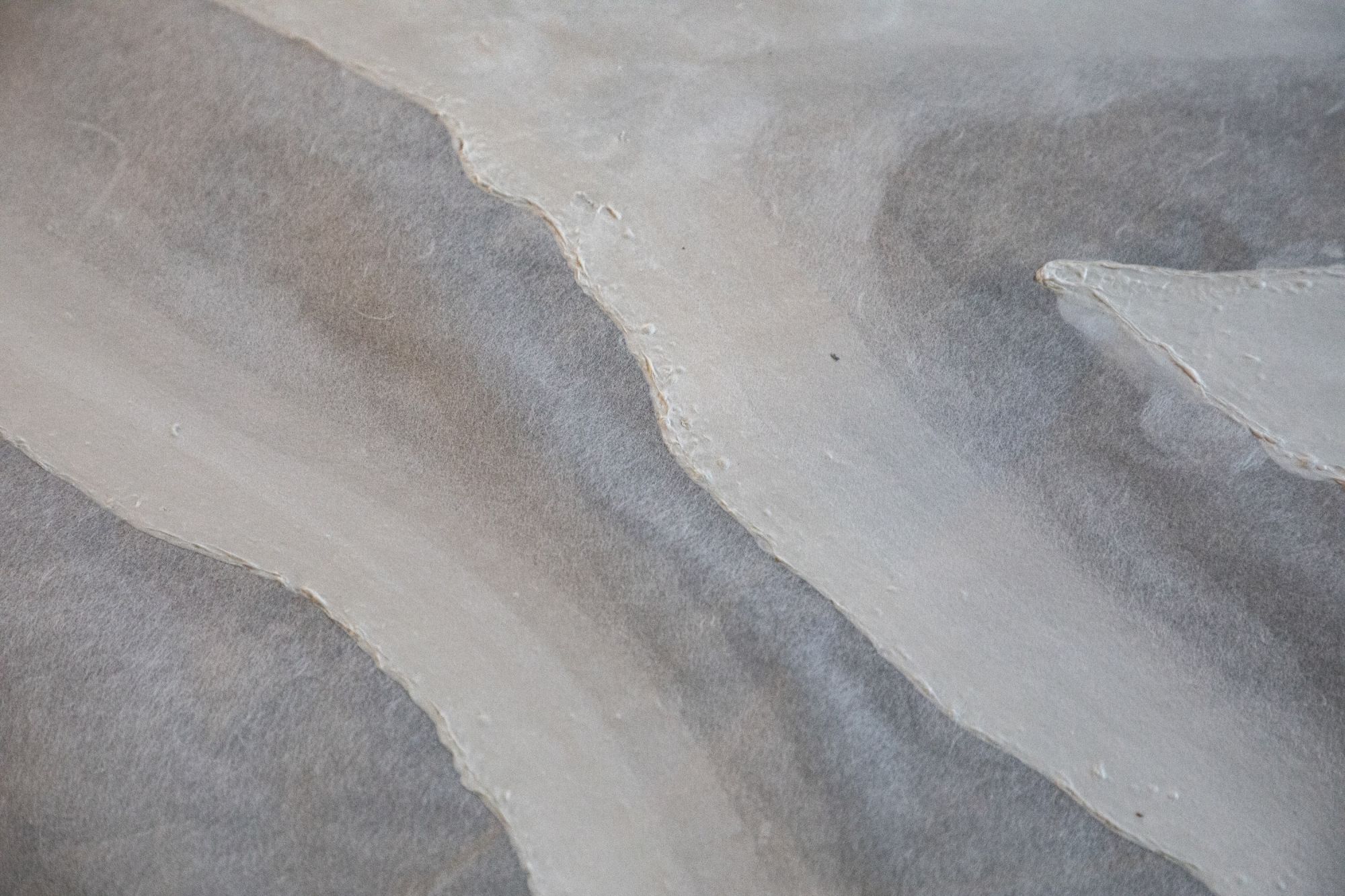 Currently, “Hiryu” is being applied to the production of decorative washi such as tapestries and lampshades as interior washi.The gallery in a separate building includes several types of lamps finished with layers of Hiryu.A beautiful gradation of patterns emerges in the light.
Currently, “Hiryu” is being applied to the production of decorative washi such as tapestries and lampshades as interior washi.The gallery in a separate building includes several types of lamps finished with layers of Hiryu.A beautiful gradation of patterns emerges in the light.
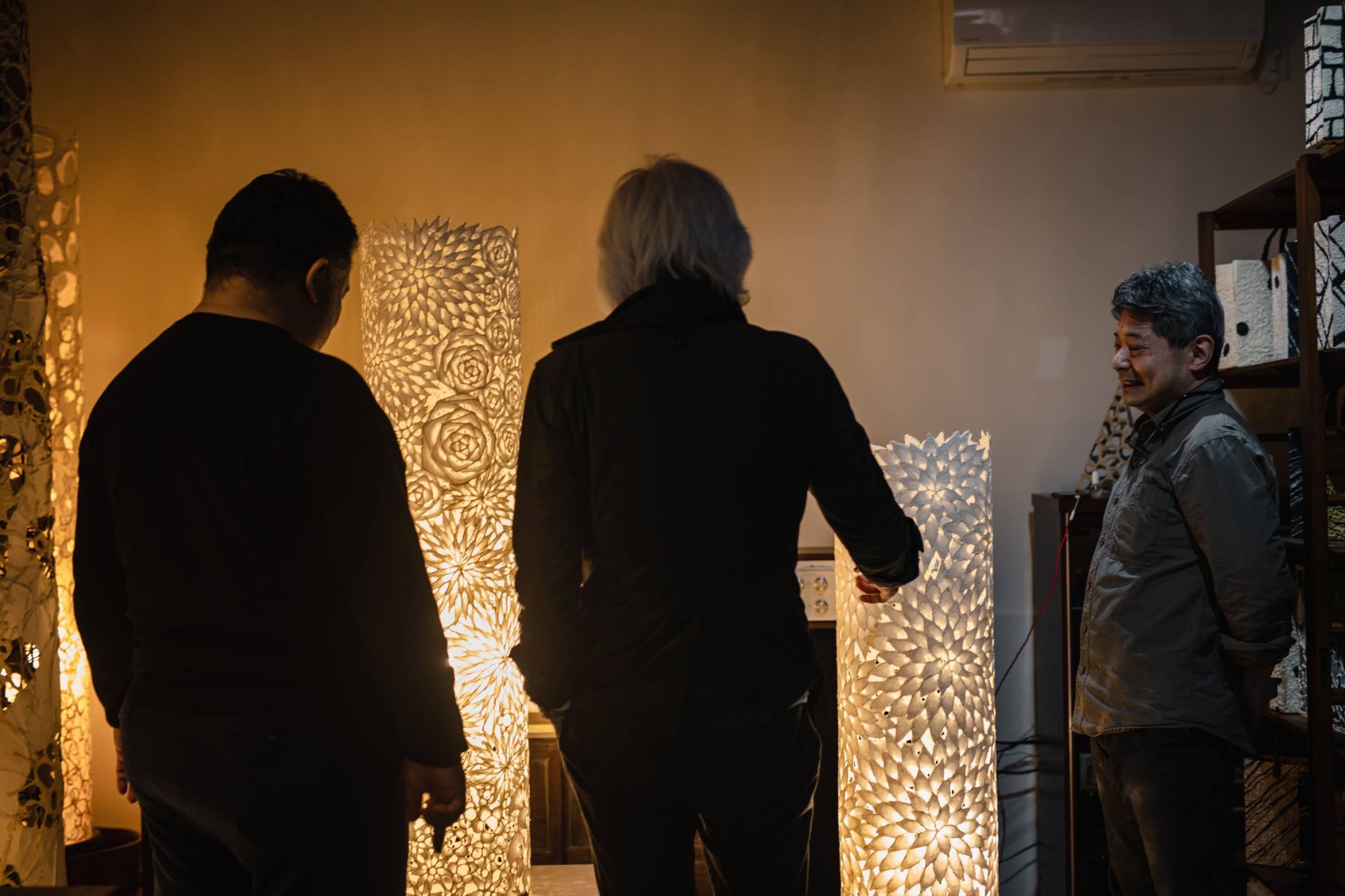 Basically, what Mr. Osada makes is custom-made.They do everything themselves, from the design to the finished product.Both Mr. Kosaka and Mr. Oikawa were happy to encounter a variety of one-of-a-kind products that are only available here! It seemed that they could not stop talking with Mr. Osada until time permitted.
Basically, what Mr. Osada makes is custom-made.They do everything themselves, from the design to the finished product.Both Mr. Kosaka and Mr. Oikawa were happy to encounter a variety of one-of-a-kind products that are only available here! It seemed that they could not stop talking with Mr. Osada until time permitted.
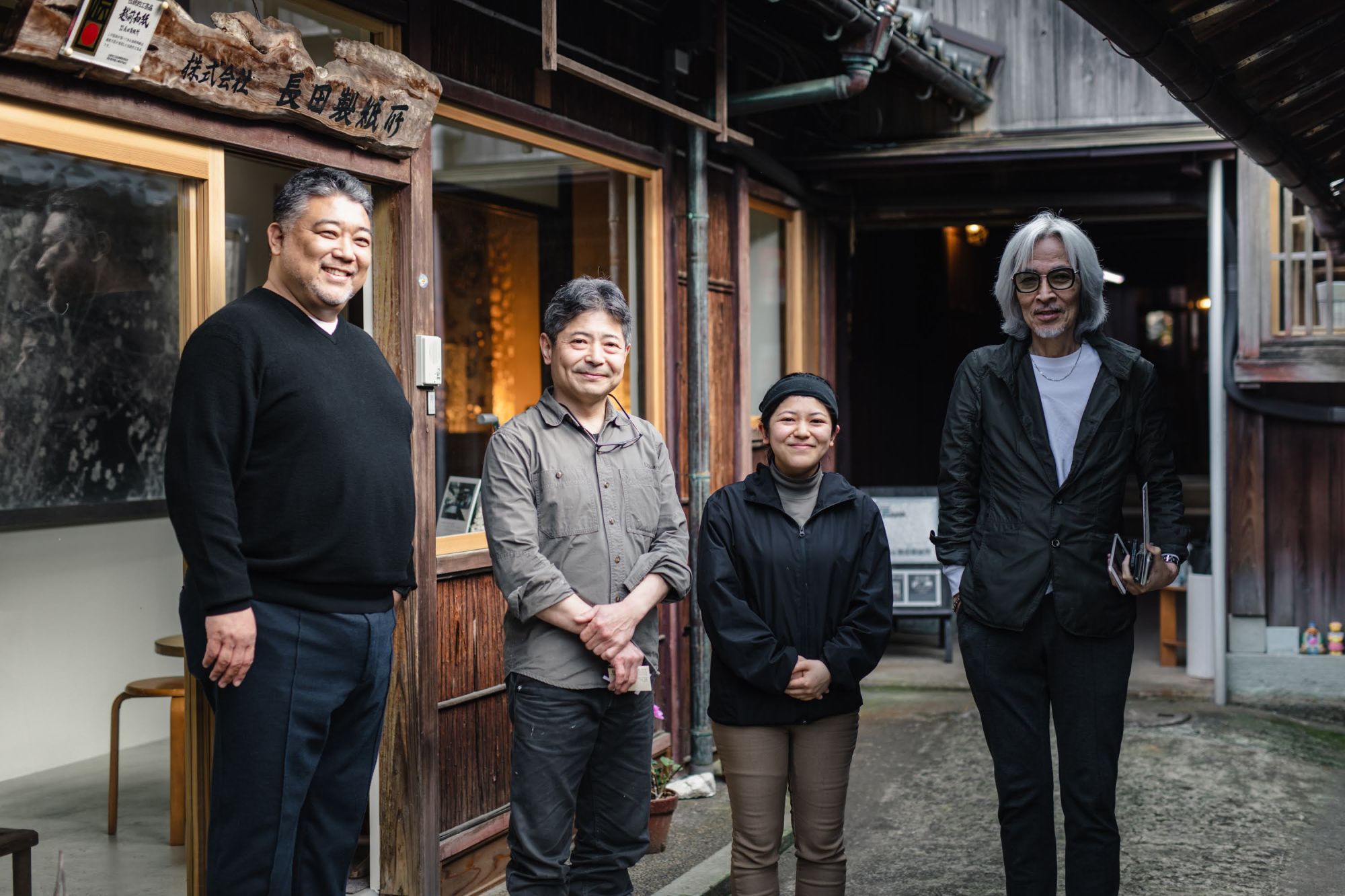
Next we came to “Yanase Washi Paper."Haruo Yanase, the second generation, will talk about the manufacturing of Yanase Washi.
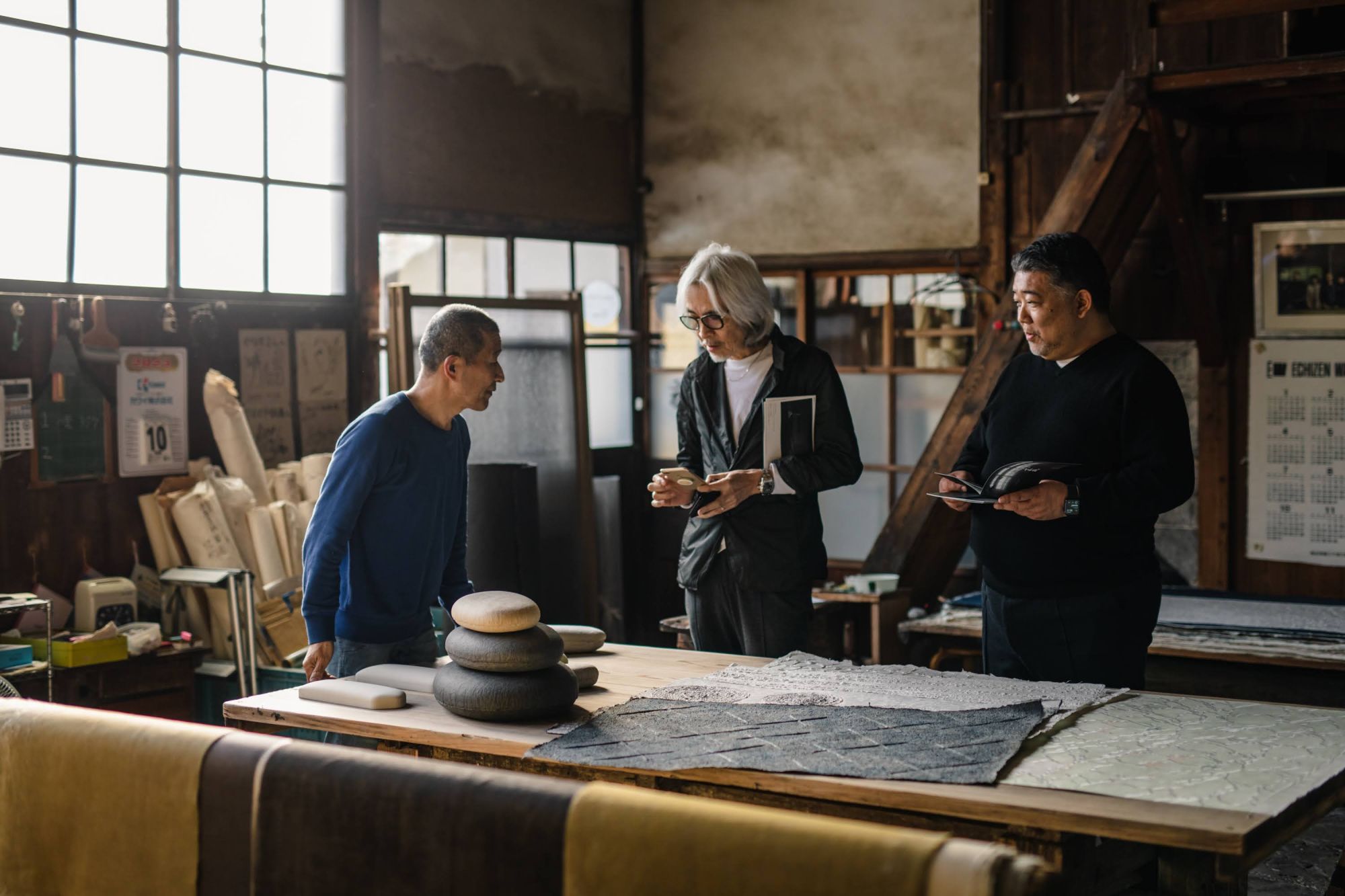 “We mainly make plain and patterned fusuma paper.It is our policy not to refuse any requests related to washi.Many people who have been rejected by other production centers often come to Echizen Washi production centers, and the accumulation of various experiences is a source of sustenance for us.” said Mr.Yanase.
“We mainly make plain and patterned fusuma paper.It is our policy not to refuse any requests related to washi.Many people who have been rejected by other production centers often come to Echizen Washi production centers, and the accumulation of various experiences is a source of sustenance for us.” said Mr.Yanase.
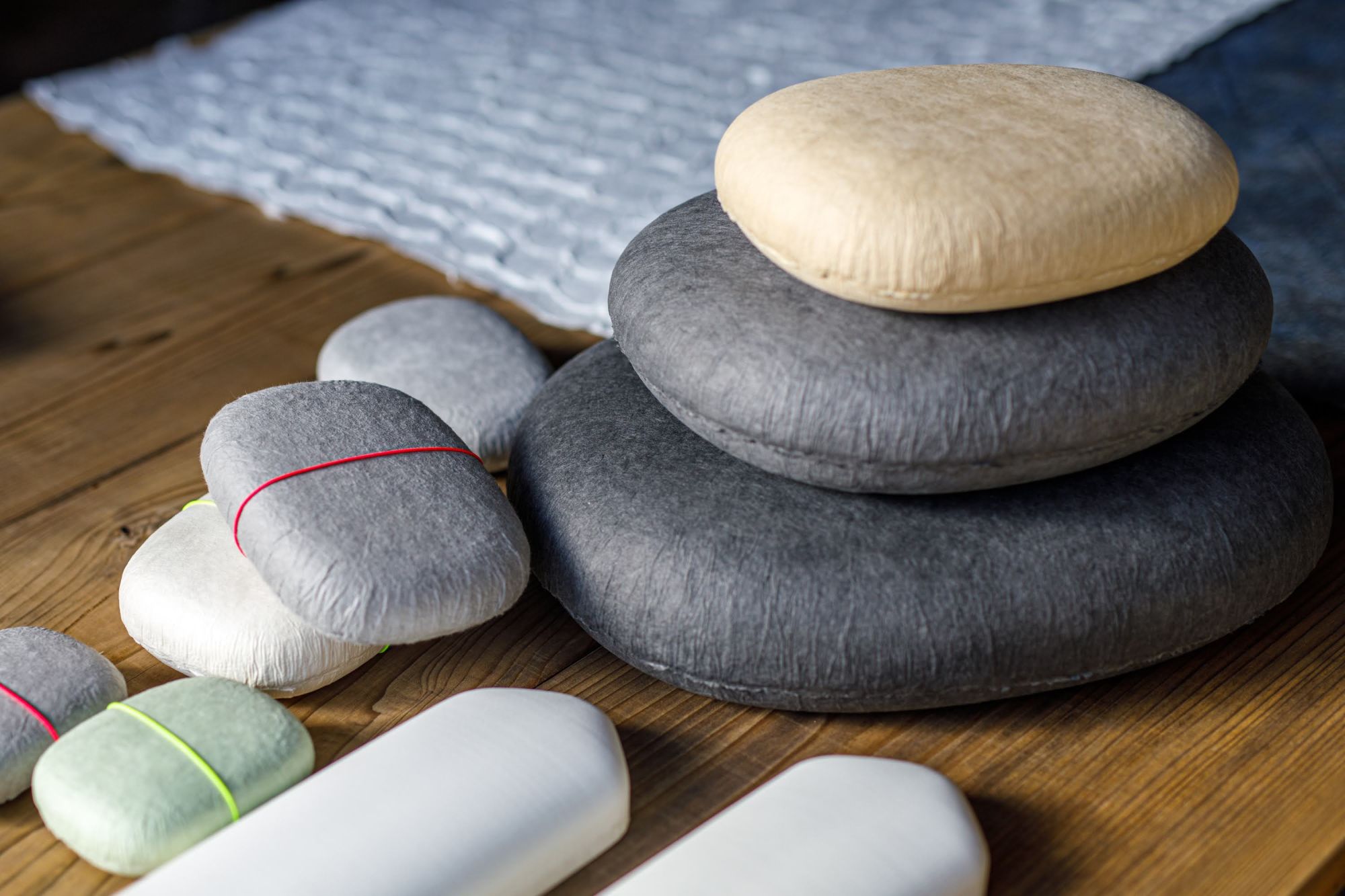 In recent years, the “Harukami” series of washi paper boxes, created in collaboration with designer Shoki Matsuyama, has become a hot topic.The box, resembling a work of art, features a design that combines the soft texture unique to washi paper, making it a perfect fit for both traditional Japanese aesthetics and modern interiors.
In recent years, the “Harukami” series of washi paper boxes, created in collaboration with designer Shoki Matsuyama, has become a hot topic.The box, resembling a work of art, features a design that combines the soft texture unique to washi paper, making it a perfect fit for both traditional Japanese aesthetics and modern interiors.
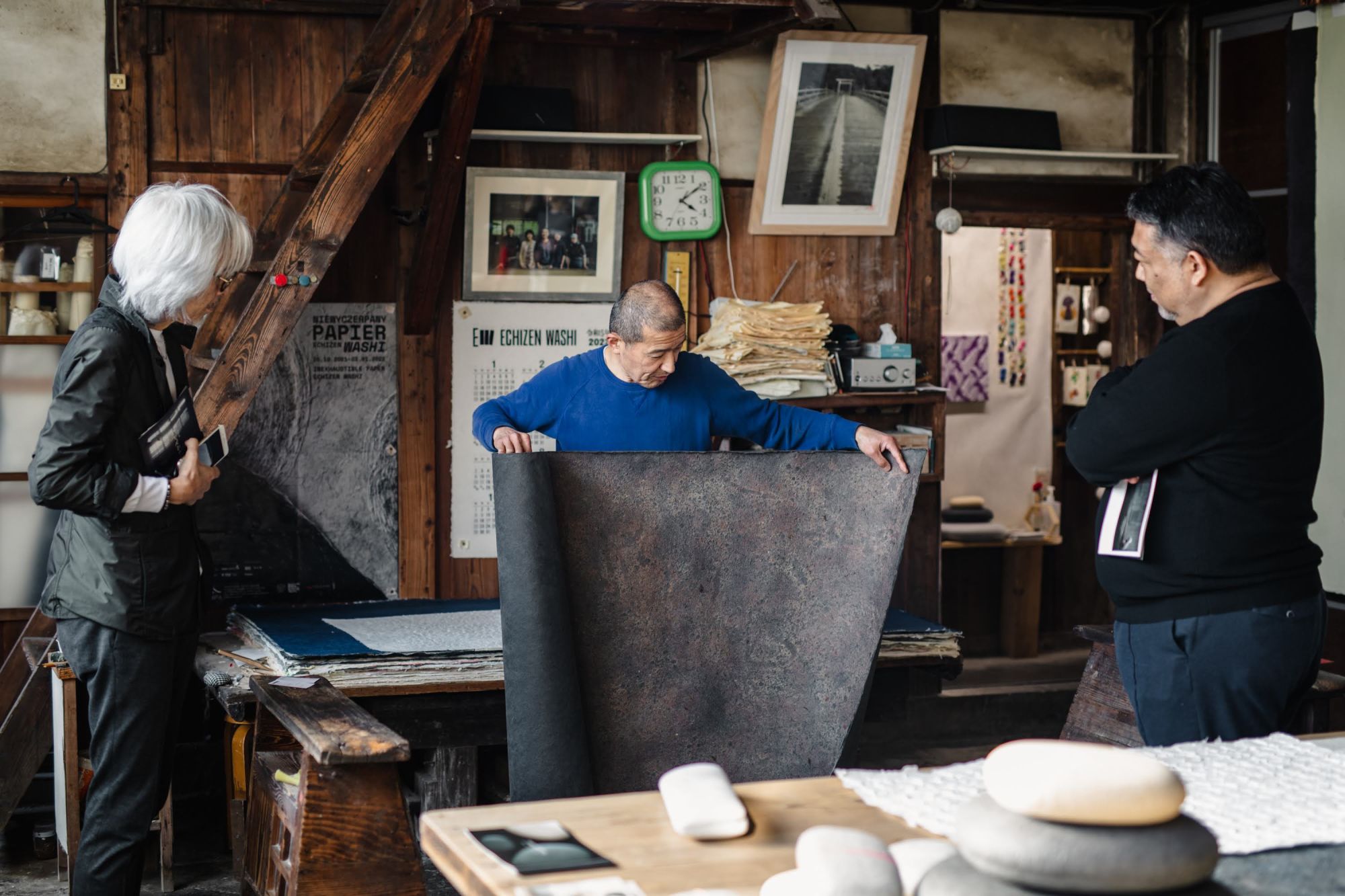 Echizen Washi has a traditional song known as the "Papermaking Song," and Mr. Yanase also performed a verse for us.
Echizen Washi has a traditional song known as the "Papermaking Song," and Mr. Yanase also performed a verse for us.
Born in Goka, learning papermaking, turning people with a seated Benkei style.
Inheriting the craft of papermaking as it is, both parents and children, even grandchildren, make paper.
Learning papermaking from seven or eight years old, still unaware of the proper kneading balance.
Even lords and shoguns rely on the fine washi paper of Goka no Hōsho.
The work learned from the Kawakami family, how could it be carelessly changed?
With a pure heart, made with clear water, the color of the dried official documents is as white as snow.
Be patient, patience is gold, patience turns the tree into gold.
Though the day ends with calls to finish, the work remains unfinished at day's close.
~From “The Papermaker's Song”~
As can be seen from the songs, each craftsman takes pride in their work, and a culture of friendly competition seems to have taken root from long ago.
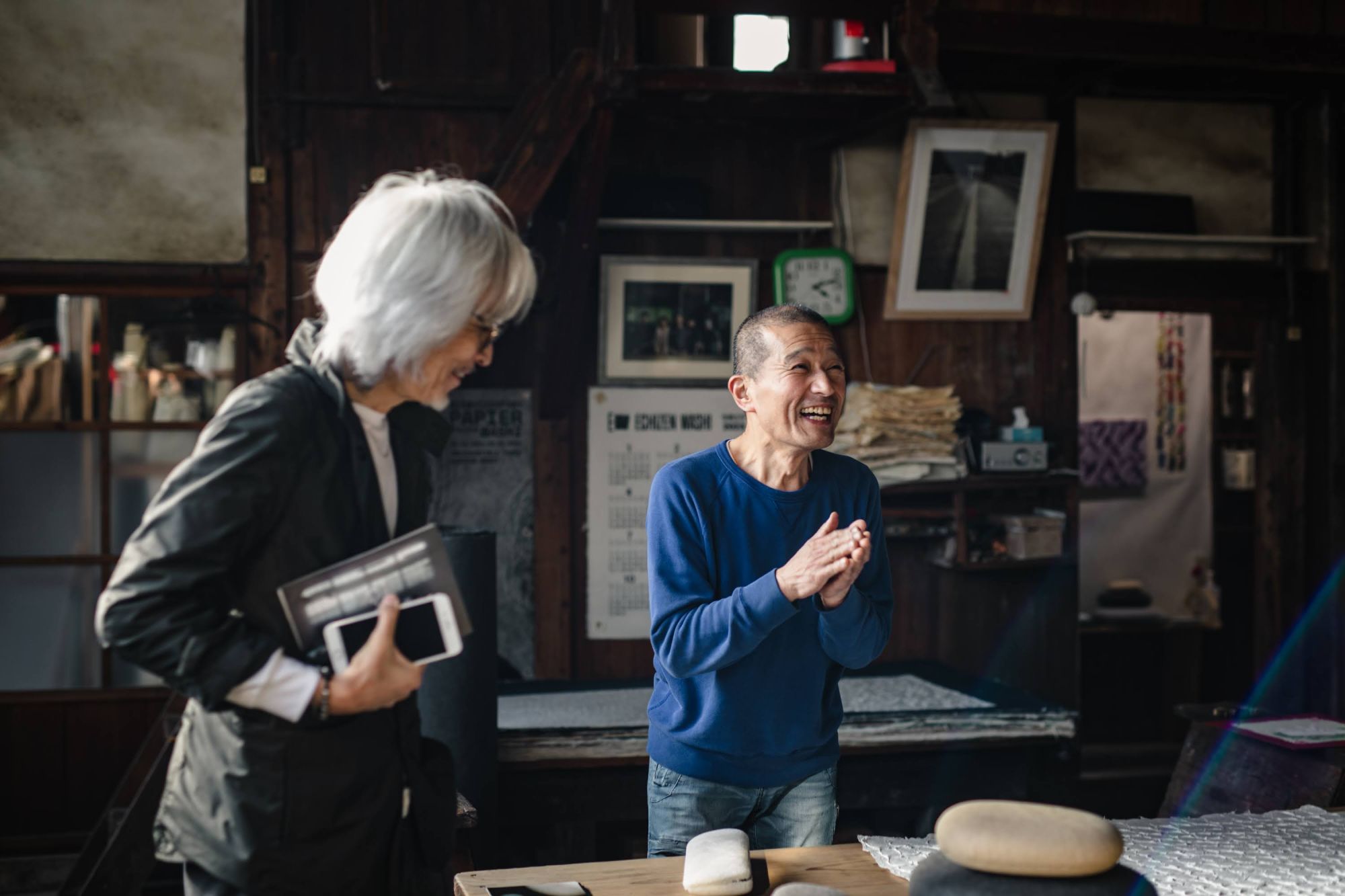
The last stop on the first day was "Sugihara Store", located a few minutes' drive from Yanase Washi.As a wholesaler of washi, they plan and sell Echizen washi throughout the world in cooperation with artisans in the production area.
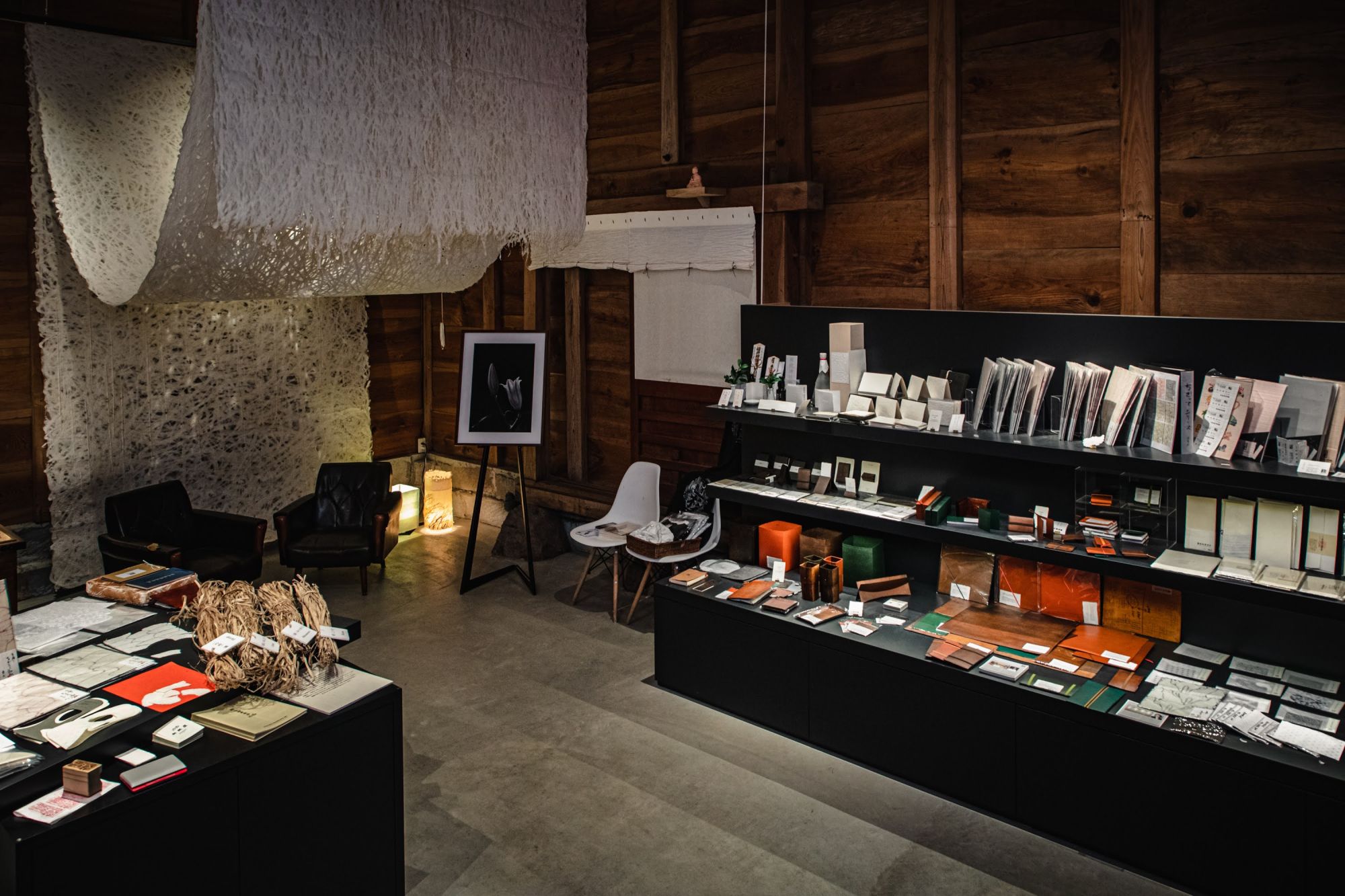 The gallery, a renovated warehouse, is filled with a variety of washi products.We will once again ask Yoshinao Sugihara, the representative known as the Echizen Washi Sommelier, about the charm of Echizen Washi.
The gallery, a renovated warehouse, is filled with a variety of washi products.We will once again ask Yoshinao Sugihara, the representative known as the Echizen Washi Sommelier, about the charm of Echizen Washi.
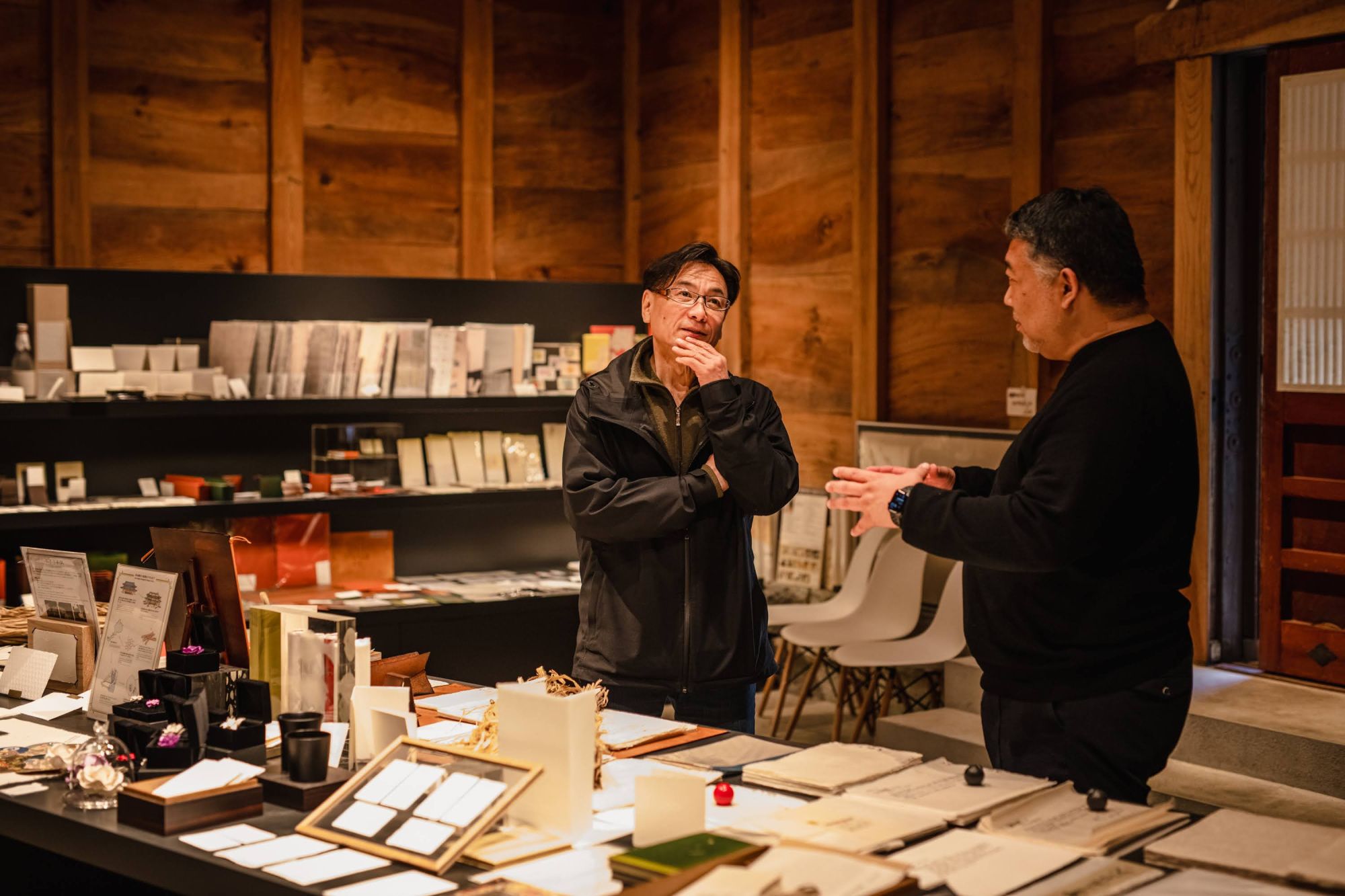 The charm of Echizen washi, says Mr.Sugihara,is that “you can do anything”.
The charm of Echizen washi, says Mr.Sugihara,is that “you can do anything”.
“Echizen City is a major paper-making center with about 300 papermakers.Echizen is home to one of Japan's two living national treasures of washi, and half of the 66 traditional washi craftspeople in Japan are located in Echizen."
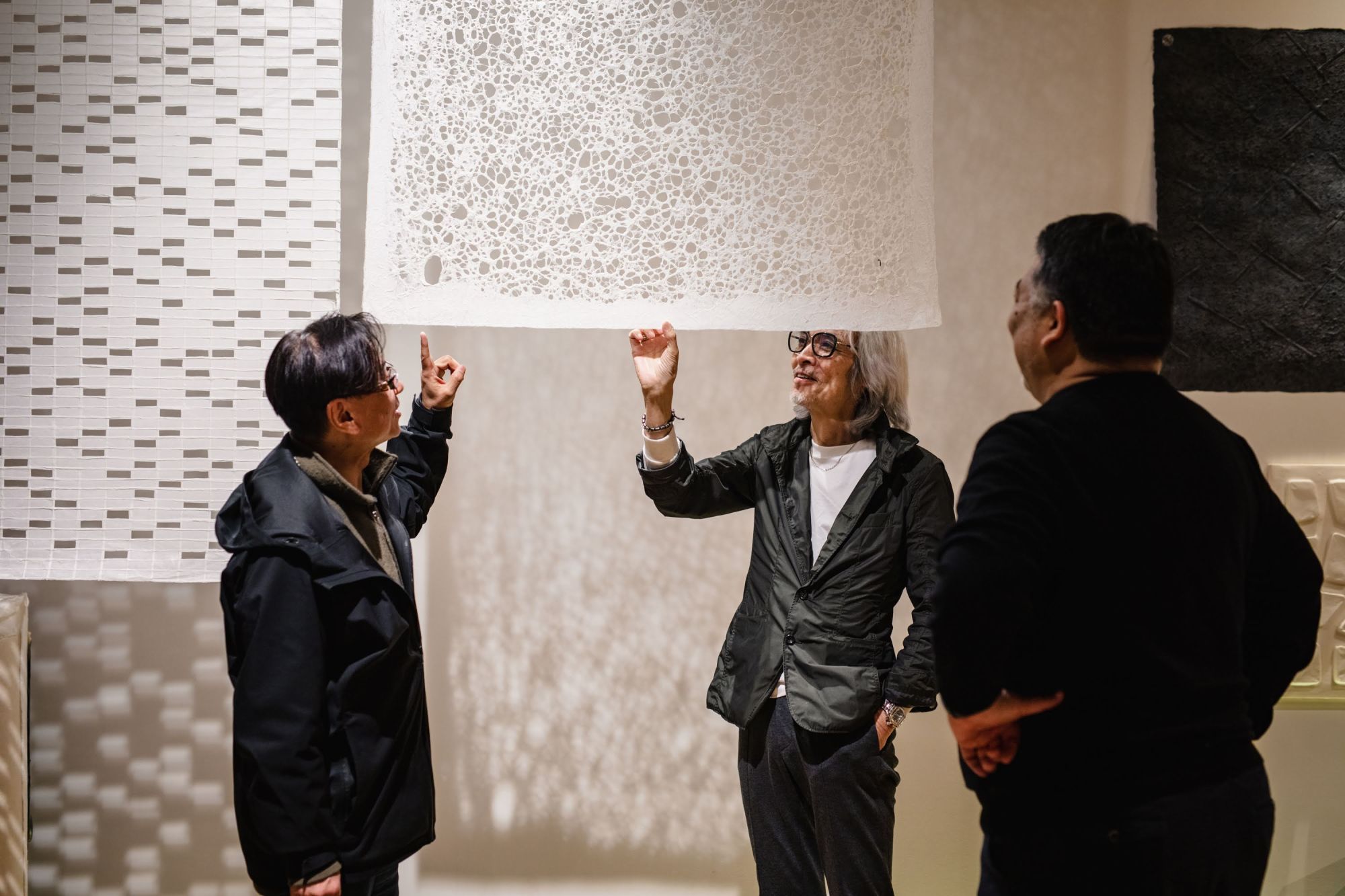 Echizen Washi is said to have been used by world famous painters such as Picasso and Rembrandt.In recent years, however, demand for Echizen washi for interior decoration has been high, and Mr. Sugihara has been expanding the possibilities of Echizen washi by connecting creators and craftspeople from around the world through exhibitions in various countries.
Echizen Washi is said to have been used by world famous painters such as Picasso and Rembrandt.In recent years, however, demand for Echizen washi for interior decoration has been high, and Mr. Sugihara has been expanding the possibilities of Echizen washi by connecting creators and craftspeople from around the world through exhibitions in various countries.
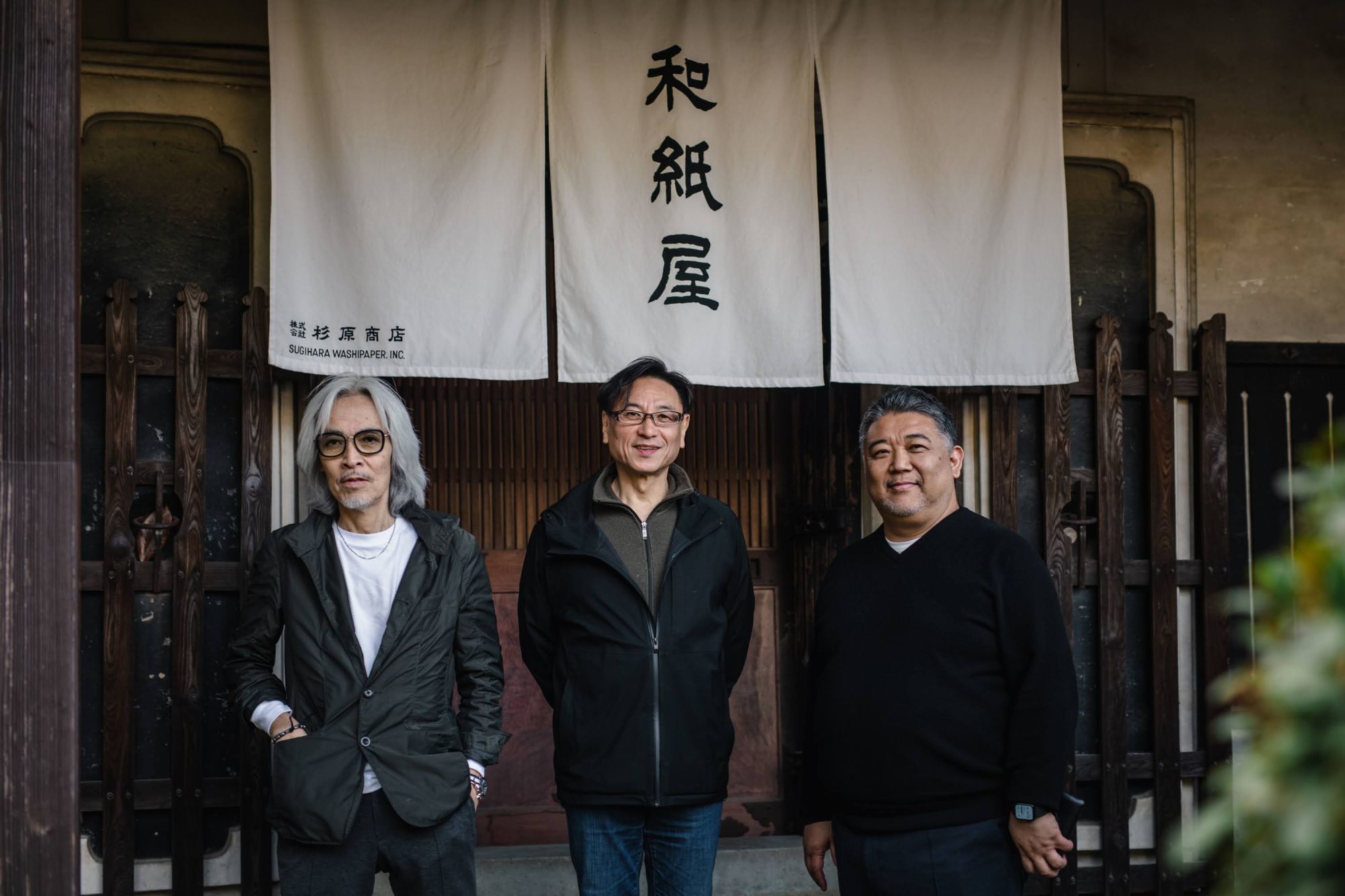 “ If you ask a craftsman,’Can you do this?’ the answer should not be ‘No’. That's how good the area is to be able to do anything.I hope that you will continue your discussions with various craftspeople tomorrow, and use them as inspiration for new products,” he said, sharing his unique way of enjoying the production area as only a washi sommelier can.
“ If you ask a craftsman,’Can you do this?’ the answer should not be ‘No’. That's how good the area is to be able to do anything.I hope that you will continue your discussions with various craftspeople tomorrow, and use them as inspiration for new products,” he said, sharing his unique way of enjoying the production area as only a washi sommelier can.
The first of the second day came to “Igarashi Paper".
Founded in 1919, the company produces a wide range of washi, from large-format paper to small items, with a focus on fusuma and wallpaper. In recent years, its exceptional craftsmanship has been highly regarded, as seen in the development of "Food Paper," made using food ingredients, and custom-made paper for renowned artists.
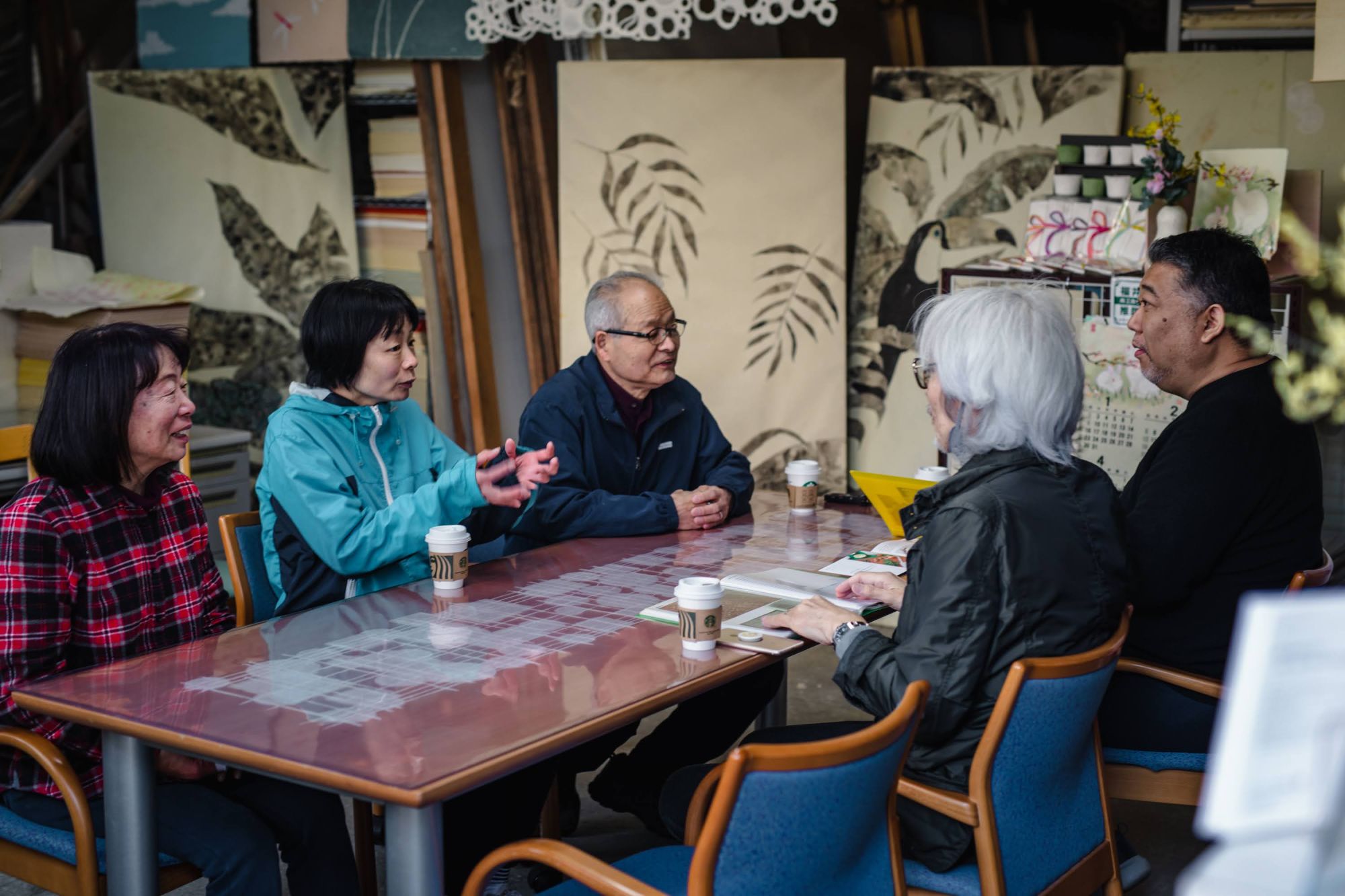 Among them, Igarashi Washi handmade large-format creative washi paper is used in a variety of spaces, including hotels, restaurants, public facilities, and cultural institutions.
Among them, Igarashi Washi handmade large-format creative washi paper is used in a variety of spaces, including hotels, restaurants, public facilities, and cultural institutions.
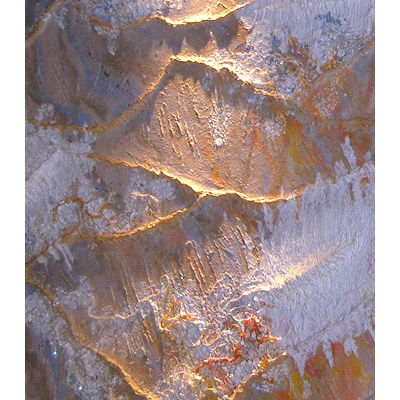
The traditional technique has been further evolved, and even three-dimensional expression is possible despite being made of Japanese paper.It has a texture similar to an oil painting, with raised and recessed areas, making it look as if a painting has been created.
"I don't think I'll ever do a rough sketch,The craftsman thinks about the design in their mind, saying, ‘This is how I want it to look like,’ and then they make the picture,” explained the third generation, Mr.Kozo Igarashi.
He also showed us diverse works such as “washi glass,” a collaboration with glass, and “washi akari” (lighting).
 Of particular interest to Mr. Kosaka was a fishing bell-shaped light created by Igarashi Washi more than 10 years ago.The work was originally a failure that had been sitting in a warehouse, but the artist got an idea for a new product from it and began to draw a design.
Of particular interest to Mr. Kosaka was a fishing bell-shaped light created by Igarashi Washi more than 10 years ago.The work was originally a failure that had been sitting in a warehouse, but the artist got an idea for a new product from it and began to draw a design.
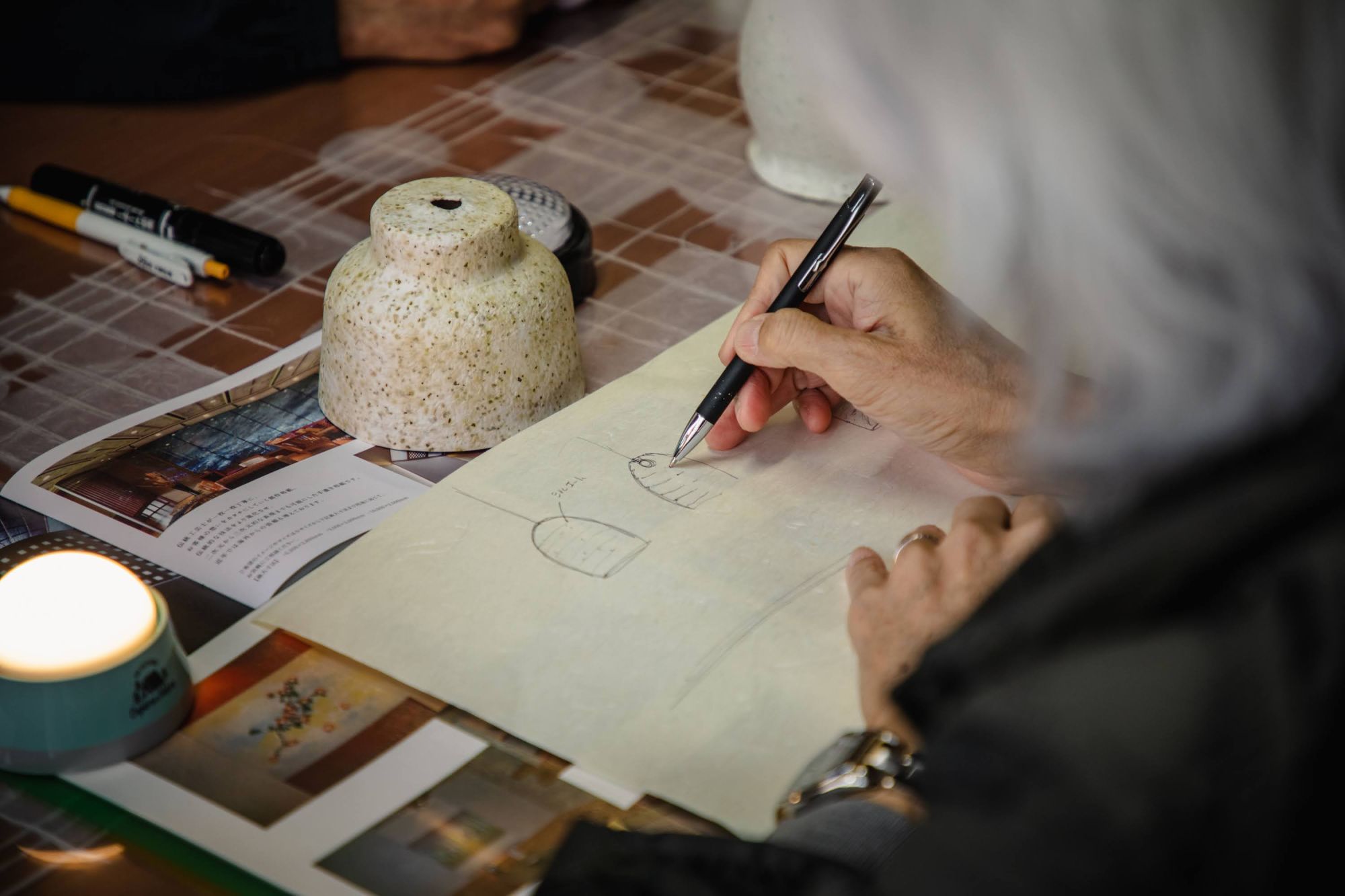 "The designer wants to see not only the finished product, but also what is considered a failure or something that has not been completed. It is not uncommon for the process of learning why something failed to inspire fantasy and generate new ideas.I would love to make something together,” Mr.Kosaka said.
"The designer wants to see not only the finished product, but also what is considered a failure or something that has not been completed. It is not uncommon for the process of learning why something failed to inspire fantasy and generate new ideas.I would love to make something together,” Mr.Kosaka said.
Future collaborations with Igarashi Paper may be born.
The last stop on this trip was the Iwano Heizaburo Paper Mill in the Imadate district.Founded in 1865, it is the largest workshop for handmade Japanese Washi in Japan.
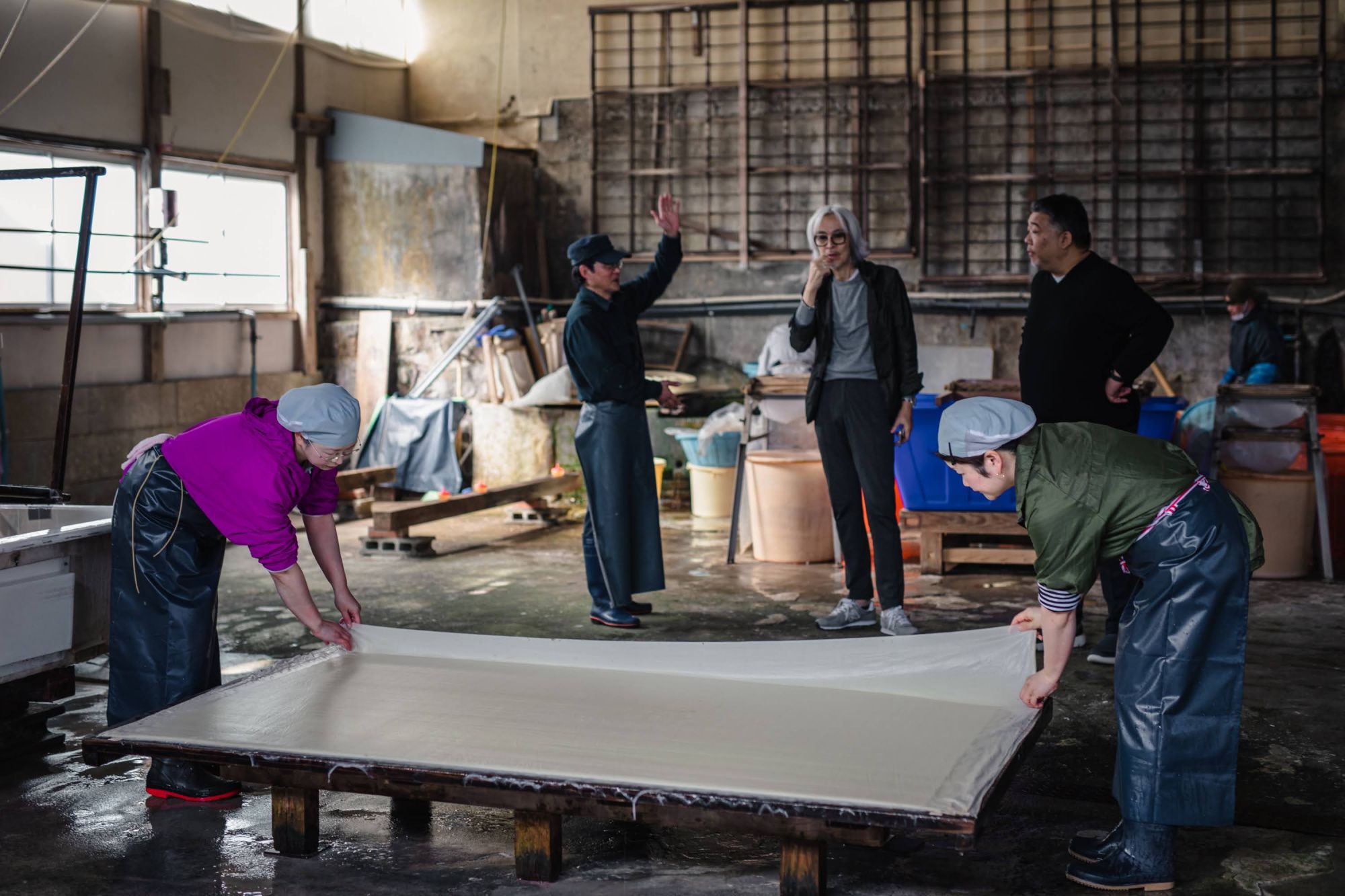 In addition to producing washi paper used by renowned artists such as Yokoyama Taikan, Hirayama Ikuo, and Higashiyama Kaii, it is one of the few paper mills capable of making washi from hemp and large-sized washi sheets, which are made by groups of four or six people.
In addition to producing washi paper used by renowned artists such as Yokoyama Taikan, Hirayama Ikuo, and Higashiyama Kaii, it is one of the few paper mills capable of making washi from hemp and large-sized washi sheets, which are made by groups of four or six people.
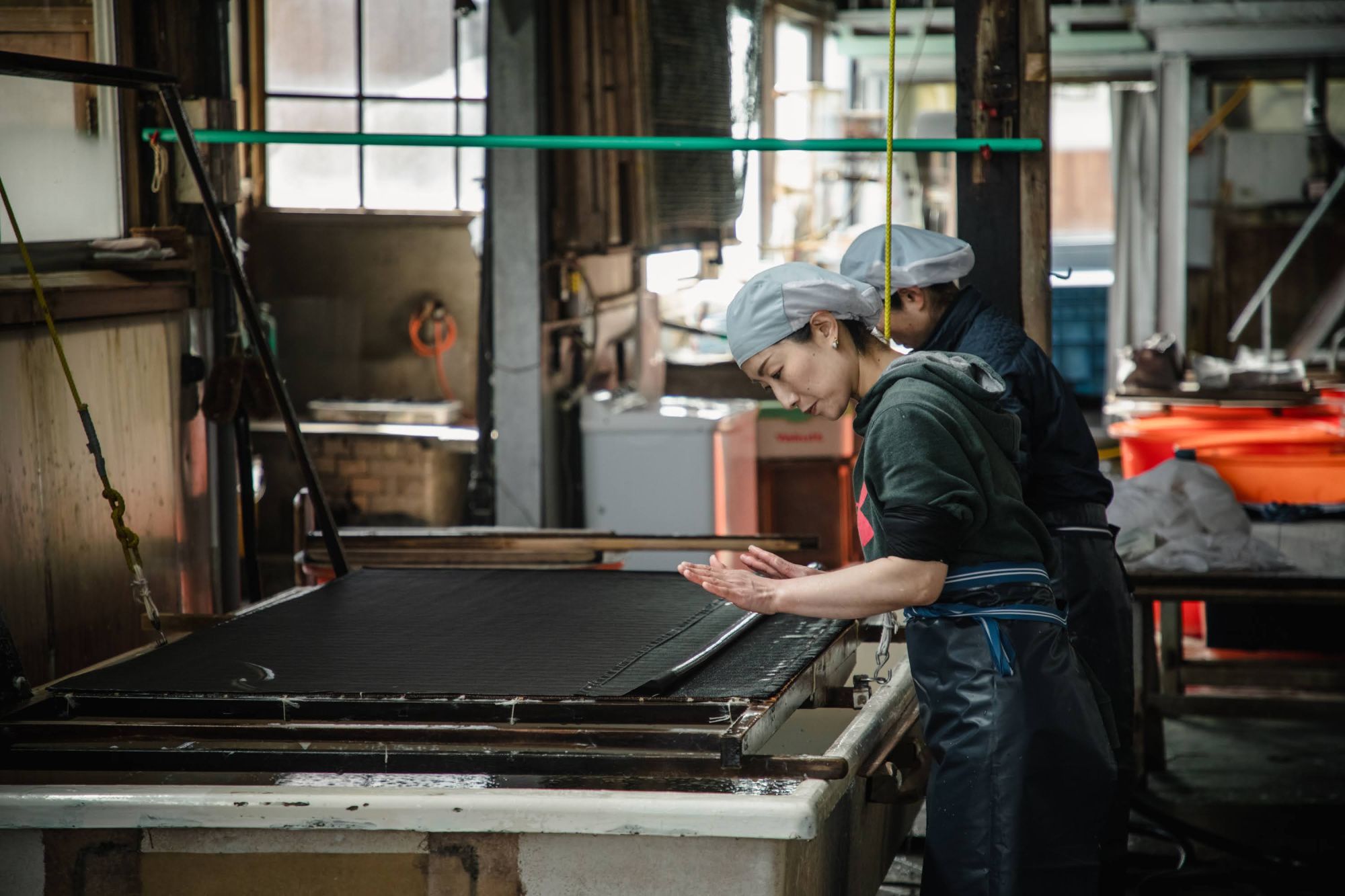 Female craftspeople make the paper in this workshop as well.We were surprised at how perfectly they breathed together, even though they were not particularly talking to each other.
Female craftspeople make the paper in this workshop as well.We were surprised at how perfectly they breathed together, even though they were not particularly talking to each other.
 This is “Neri” made from the roots of sunset hibiscus and other plants.It is said that during the nagashizuki process of making washi, the plant mucilage mixed with the paper material not only helps the fibers float evenly in the water but also strengthens the paper itself.
This is “Neri” made from the roots of sunset hibiscus and other plants.It is said that during the nagashizuki process of making washi, the plant mucilage mixed with the paper material not only helps the fibers float evenly in the water but also strengthens the paper itself.
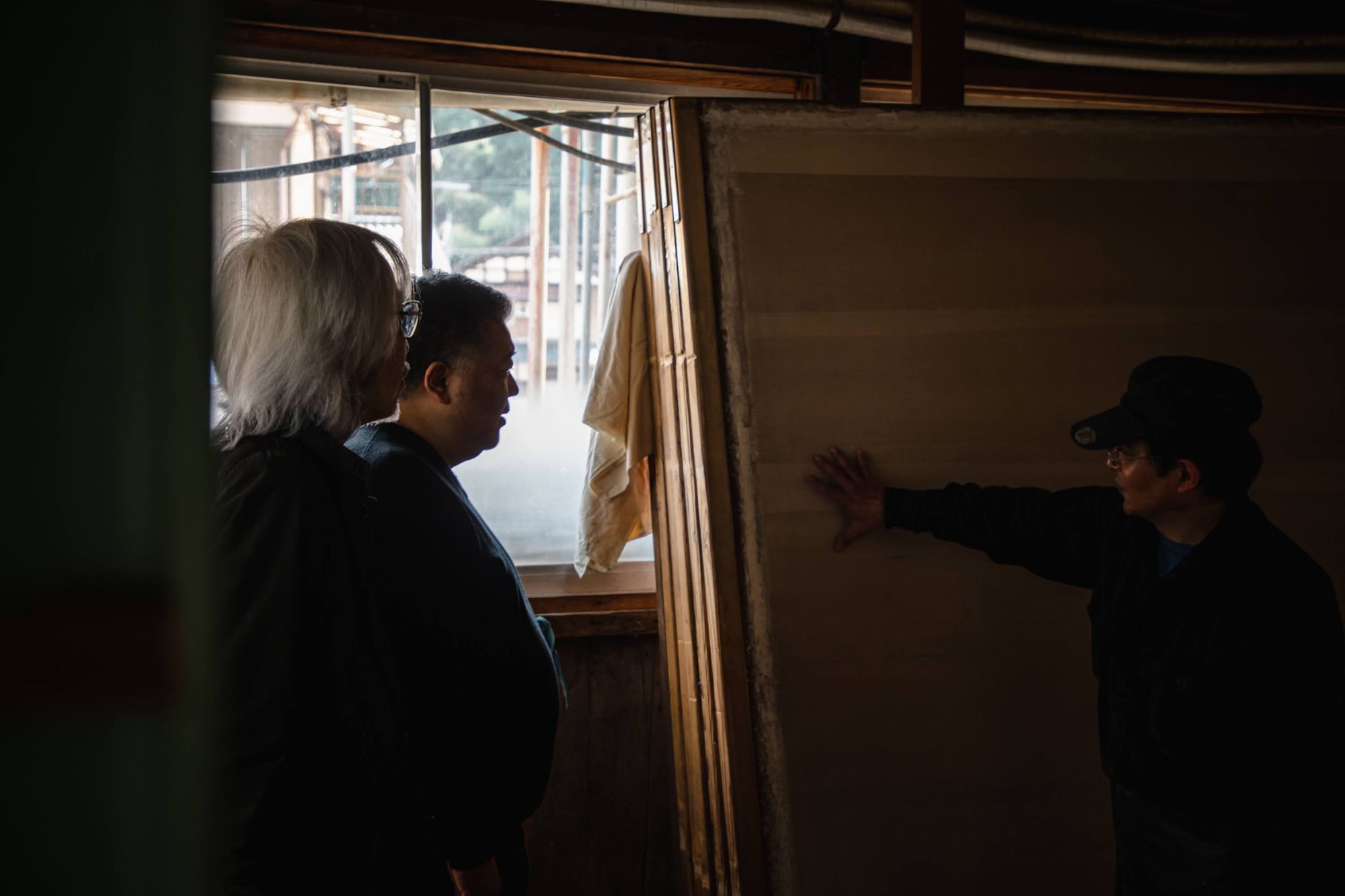 After the washi is made, it is pressed to remove the water content, then pasted one by one onto a ginkgo board and subjected to room drying (murokanso) in a warm room.
After the washi is made, it is pressed to remove the water content, then pasted one by one onto a ginkgo board and subjected to room drying (murokanso) in a warm room.
"The reason we use ginkgo nuts is that they are less likely to curl up when dried in the sun.The wood itself also has fewer knots and a smoother finish, which is why it is used in many Echizen washi factories.Furthermore, this board is made by a mounting shop that possesses sashimono techniques.Echizen has chests as well as washi, so one of the characteristics of the production area is that you can get tools used only in this area,” says Makiko Iwano, the fourth generation of Heizaburo Iwano.
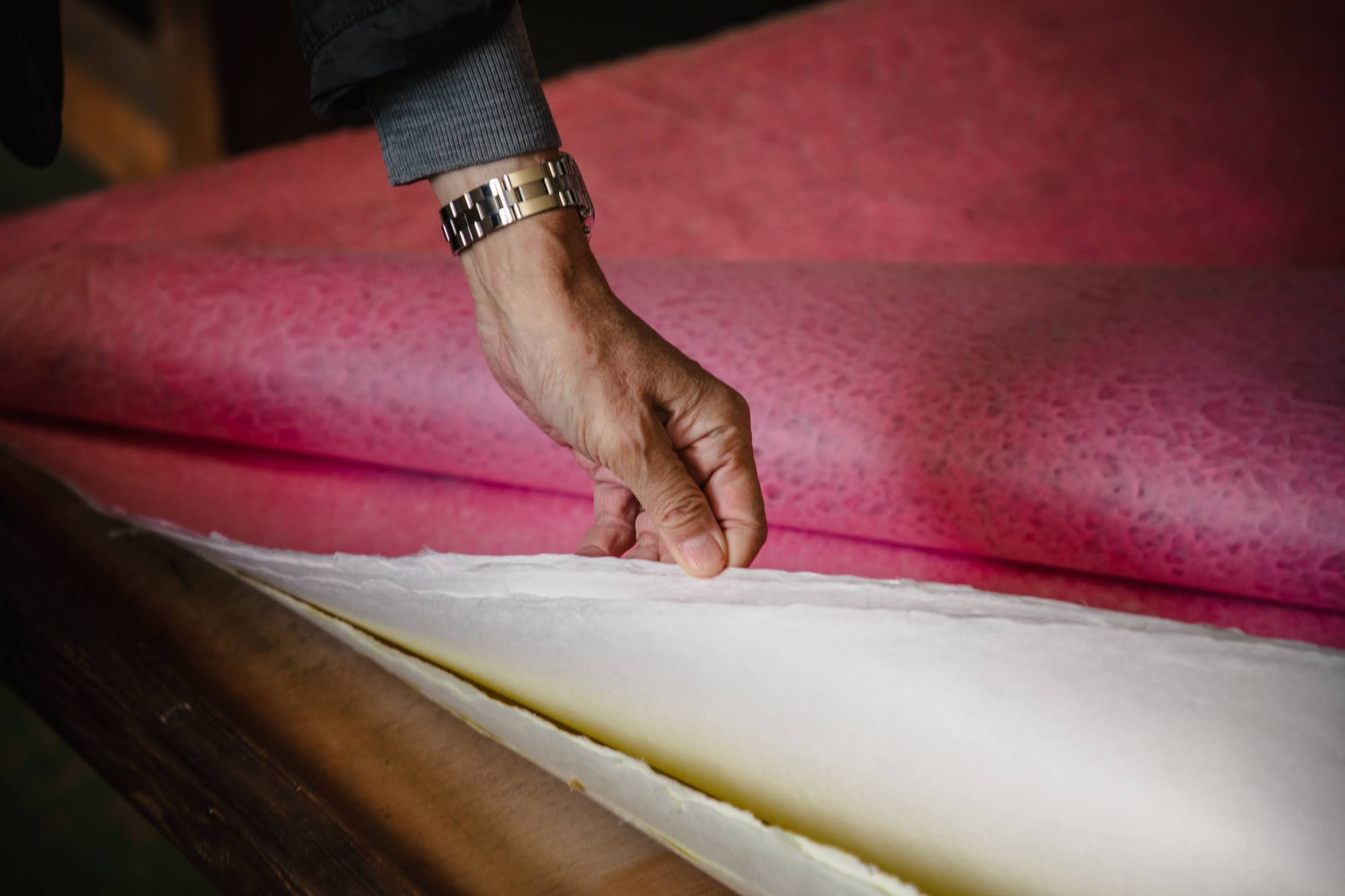 Iwano Heizaburo Paper Mills has inherited the ancient paper-making patterns of Echizen Washi and the techniques of the original Iwano Heizaburo.The craftspeople who were straight ahead in their papermaking work showed their will "to preserve this technique for future generations."
Iwano Heizaburo Paper Mills has inherited the ancient paper-making patterns of Echizen Washi and the techniques of the original Iwano Heizaburo.The craftspeople who were straight ahead in their papermaking work showed their will "to preserve this technique for future generations."
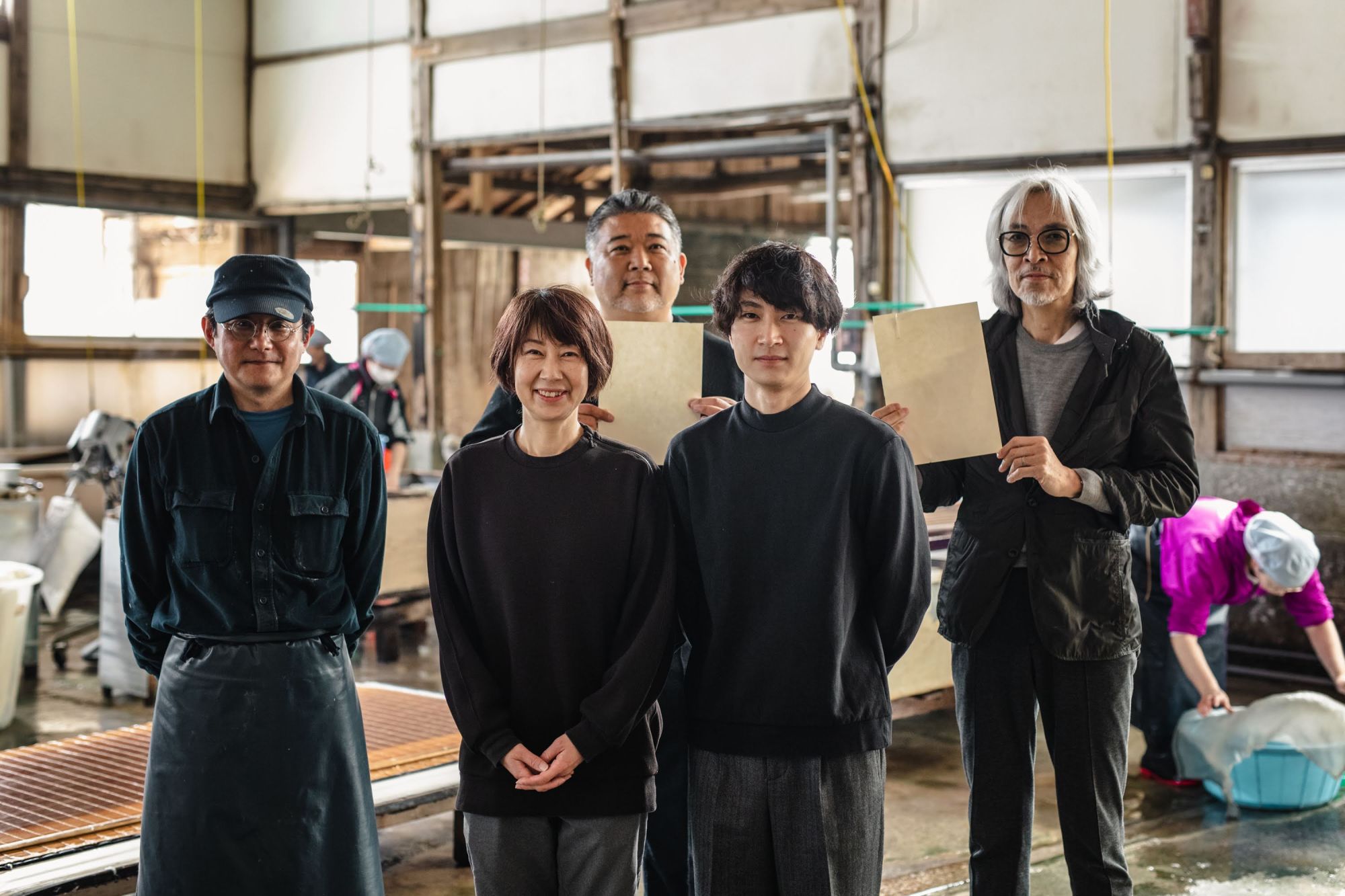
We asked the two visitors who spent two days touring Echizen washi sites what they thought of their trip.
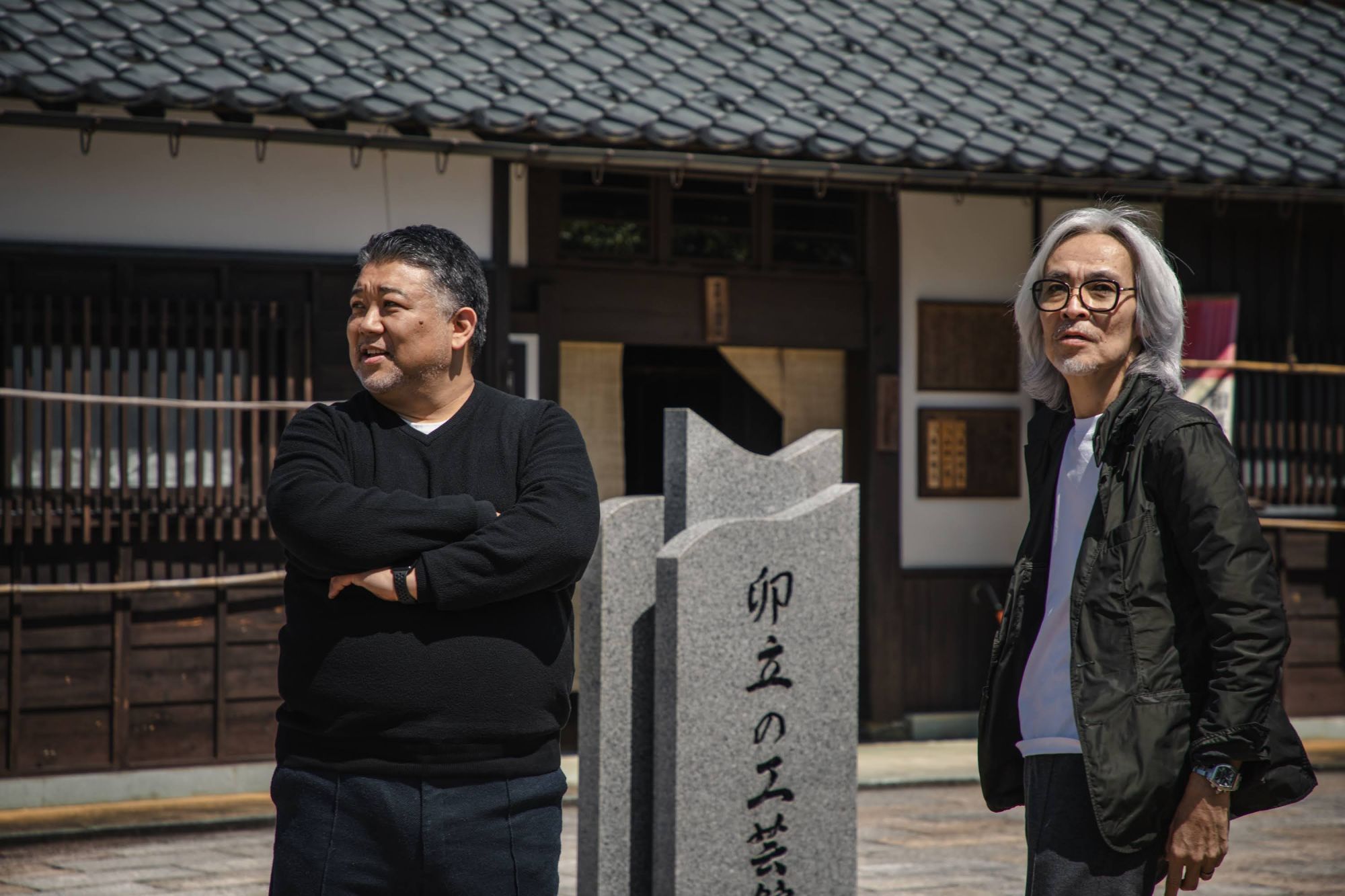 “Washi is a material I thought I knew well, having used it many times before, but there were many things I only truly understood after visiting the production area.It is amazing to see such a collection of unique workshops in a compact production area.Not only looking at it as a catalog, but also seeing the scene where it is being made makes my imagination grow,” says Mr.Kosaka.
“Washi is a material I thought I knew well, having used it many times before, but there were many things I only truly understood after visiting the production area.It is amazing to see such a collection of unique workshops in a compact production area.Not only looking at it as a catalog, but also seeing the scene where it is being made makes my imagination grow,” says Mr.Kosaka.
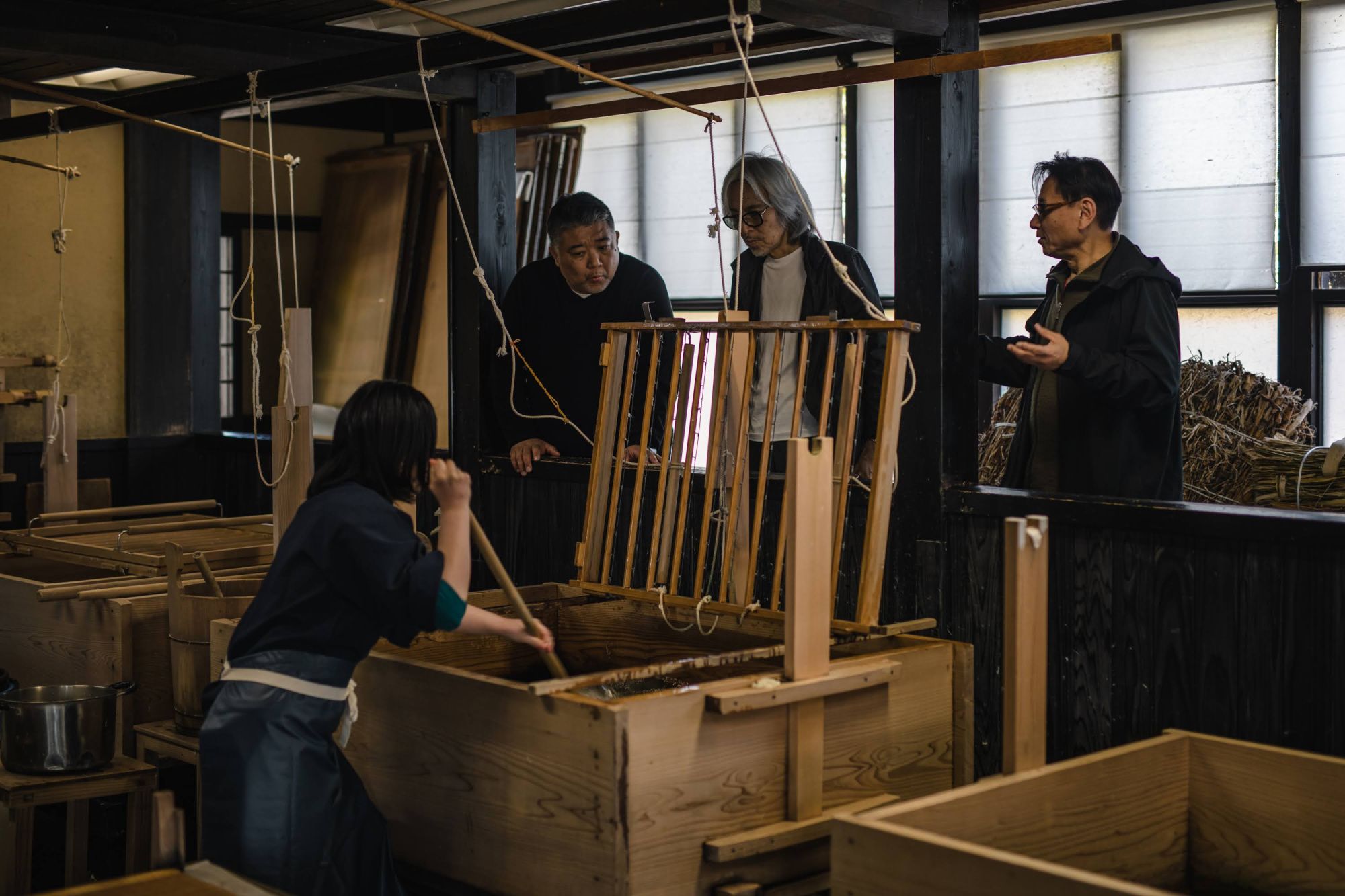 “It was interesting how, even when designers would pose difficult questions and challenges like 'Can this be done?', the craftsmen, with eyes full of curiosity, would respond, 'Yes, we can!' I also appreciated the fact that they offered suggestions beyond our imagination,” continued Mr.Oikawa.
“It was interesting how, even when designers would pose difficult questions and challenges like 'Can this be done?', the craftsmen, with eyes full of curiosity, would respond, 'Yes, we can!' I also appreciated the fact that they offered suggestions beyond our imagination,” continued Mr.Oikawa.
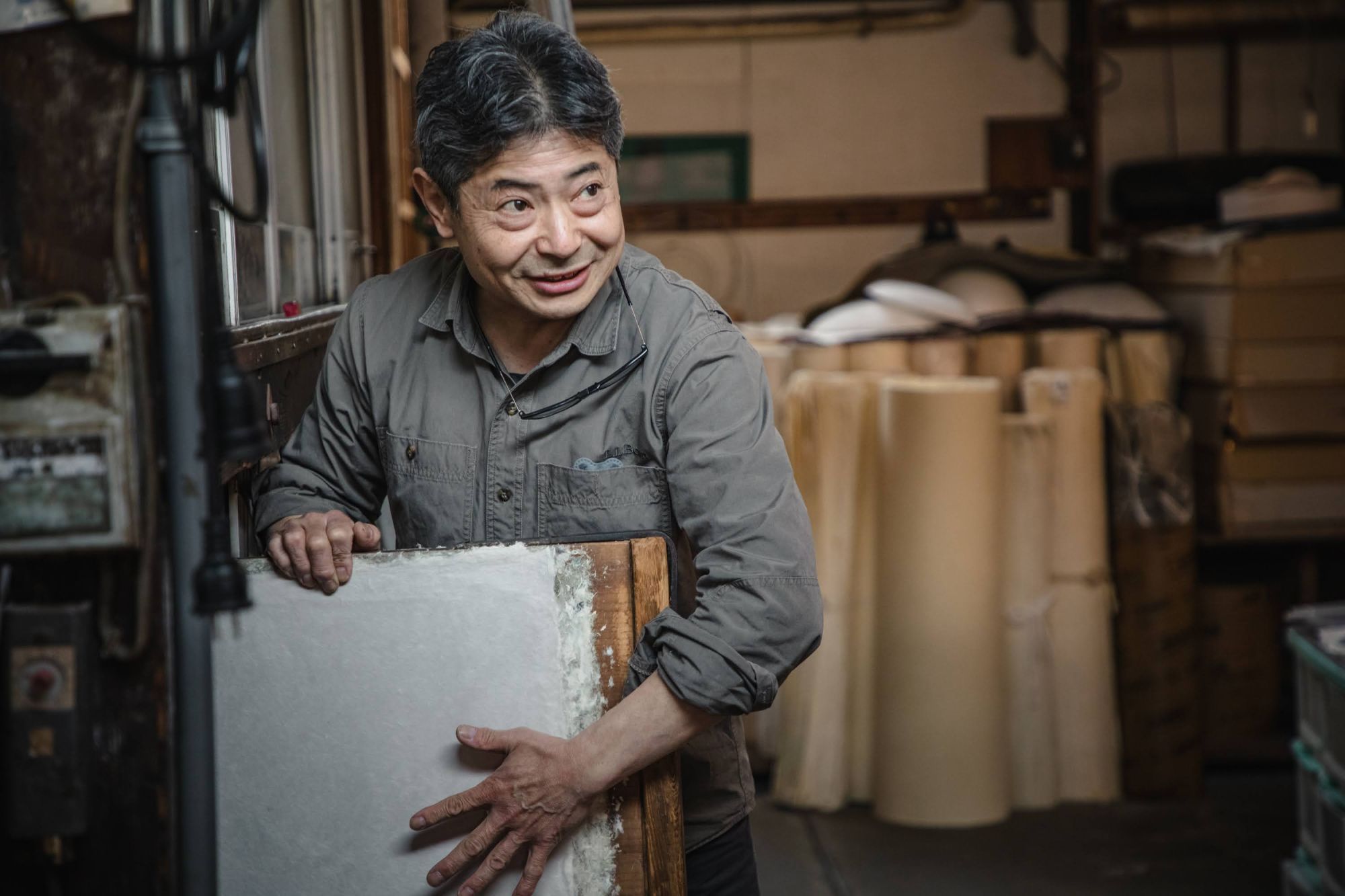 Furthermore, the fact that women are active in the manufacturing of Echizen washi paper was also a point of interest for him.With women increasingly active in the fields of interior design and architecture, a focus on the unique perspective that women bring to creation may become a key to unlocking the potential of Echizen Washi in the future.
Furthermore, the fact that women are active in the manufacturing of Echizen washi paper was also a point of interest for him.With women increasingly active in the fields of interior design and architecture, a focus on the unique perspective that women bring to creation may become a key to unlocking the potential of Echizen Washi in the future.
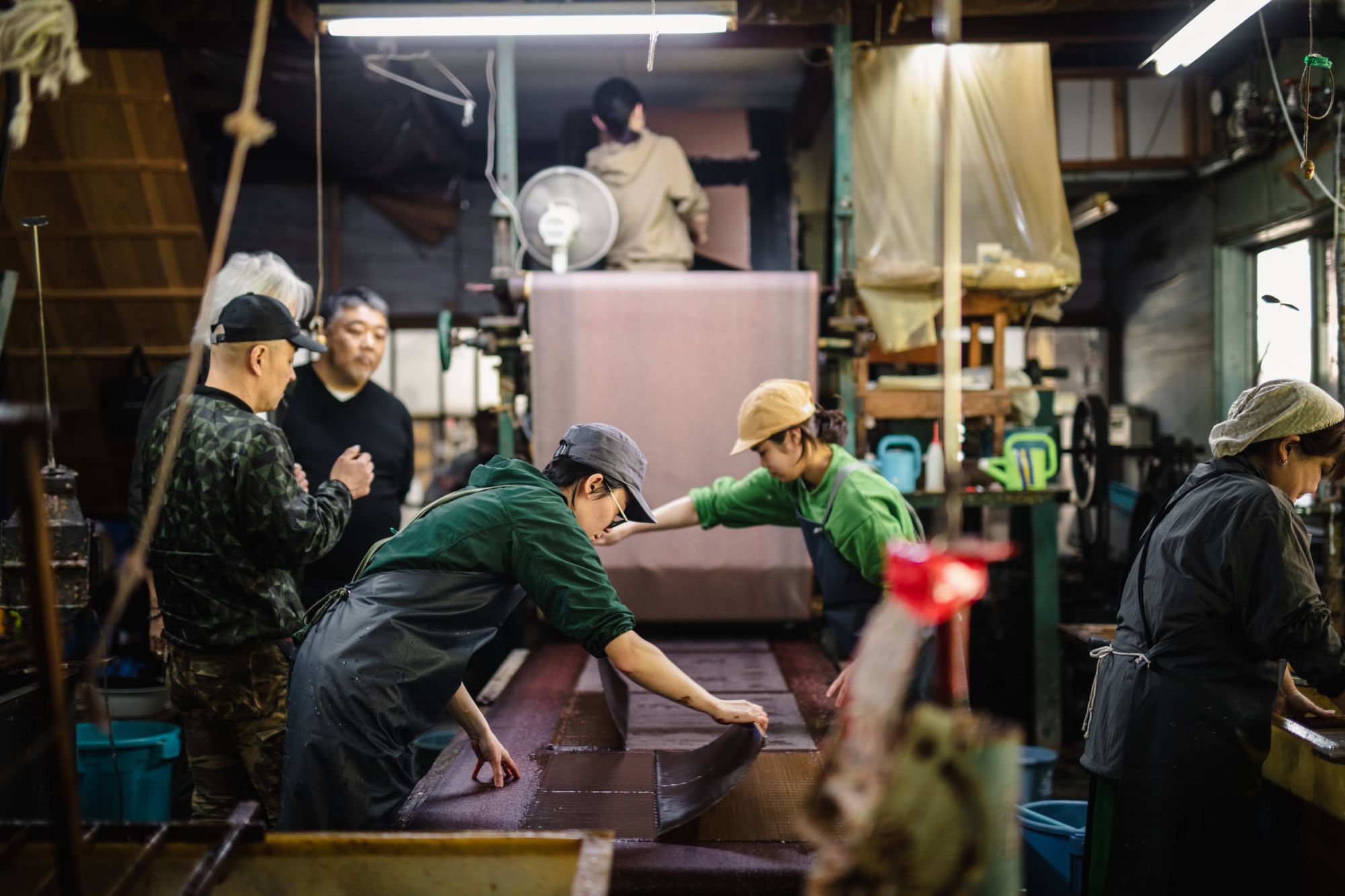 “I believe that good creations cannot be made unless we can convey the kind of people who create them and how they are made,” he said. "I would like to see young creators get out more and make it a point to meet with people in the field of manufacturing.It is stimulating and fun to be outside,” says Mr.Kosaka.
“I believe that good creations cannot be made unless we can convey the kind of people who create them and how they are made,” he said. "I would like to see young creators get out more and make it a point to meet with people in the field of manufacturing.It is stimulating and fun to be outside,” says Mr.Kosaka.
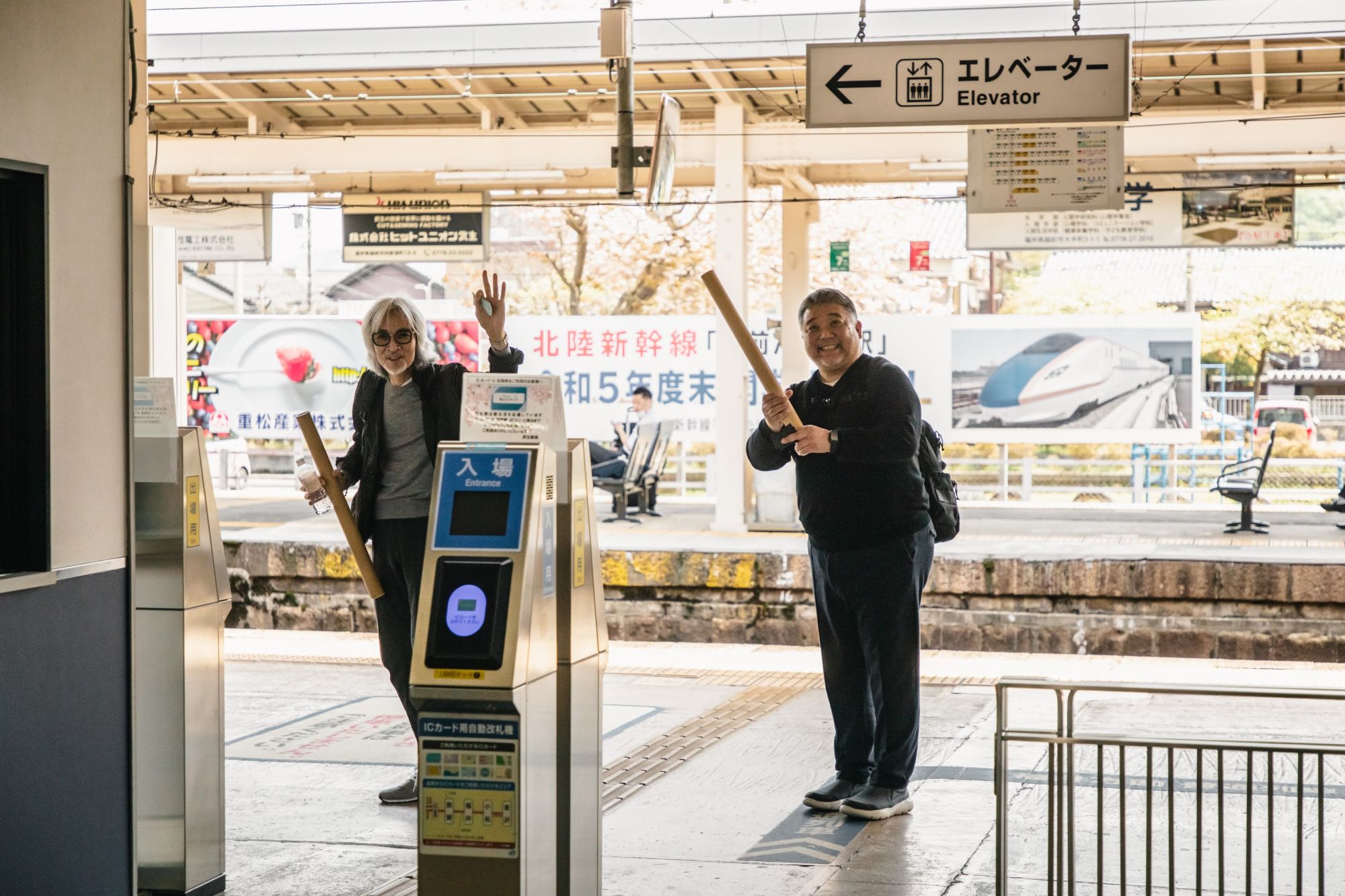
It seems that a new travel goal has emerged for them in Echizen, as they said, “Next time, We’d like to visit the regions known for Echizen forged knives and Echizen tansu (chests of drawers)!”Mr. Kosaka and Mr. Oikawa, we look forward to seeing you again!
 ▲You can view a digital pamphlet summarizing Kosaka and Oikawa's journey.
▲You can view a digital pamphlet summarizing Kosaka and Oikawa's journey.